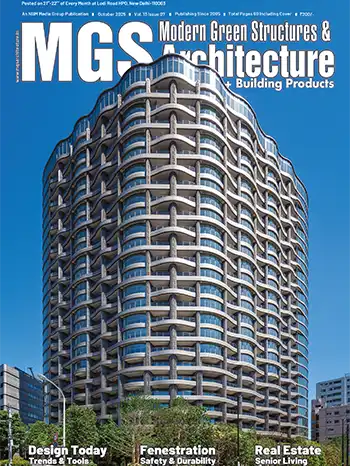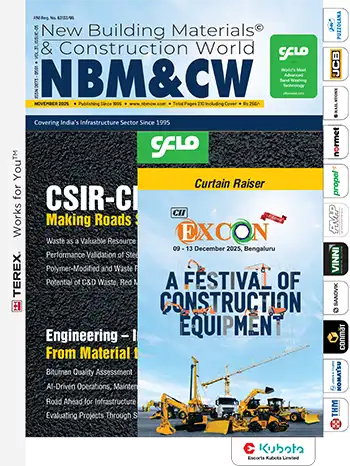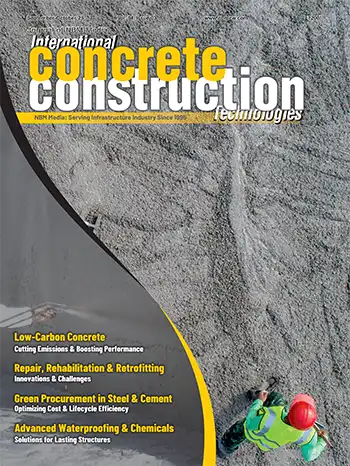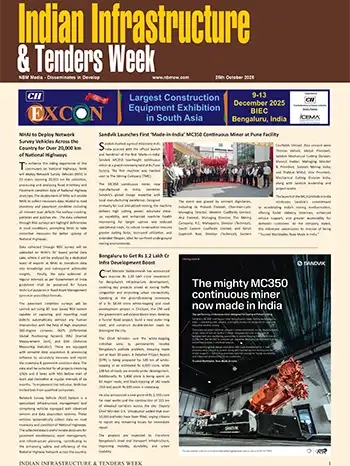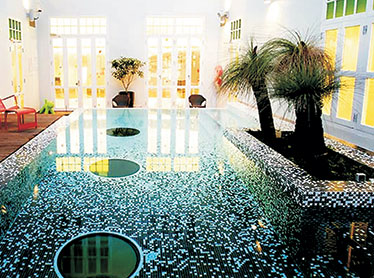
New Magestic Hotel, Singapore
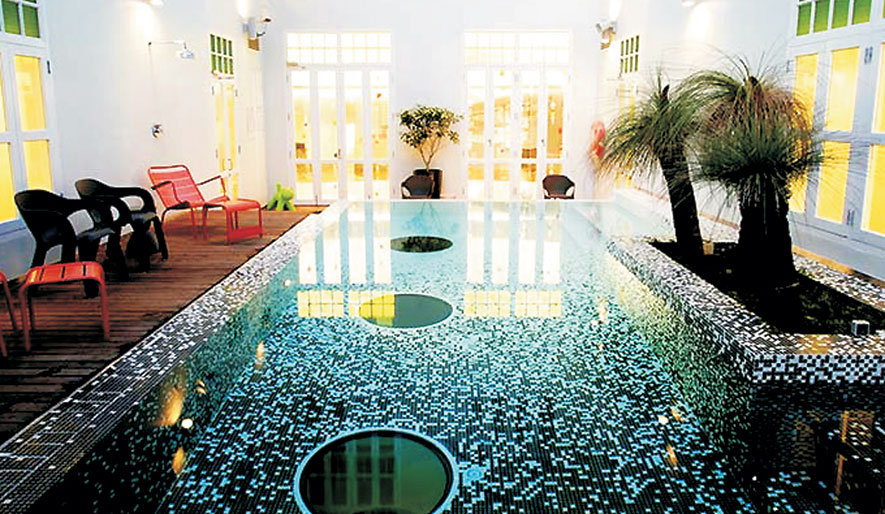
The New Majestic Hotel in Singapore has surely lived up to its name ever since it was created. This boutique hotel was the brainchild of Loh Lik Peng, a 34 yearold former lawyer who eventually went on to win the Singapore Tourism Entrepreneur of the Year 2006. The hotel developed by combining existing buildings and shops managed to retain the old colonial past and combined it with contemporary designs to give it a modern look.
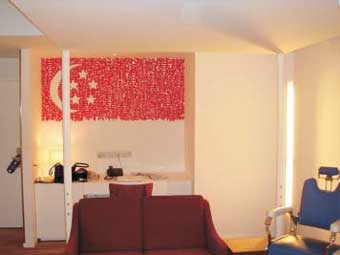
Another interesting fact about this hotel is that Peng used not one but several designers to do the interiors of the hotel. The rooms were designed by Colin Seah of Ministry of Design and five guest designers were appointed to give the hotel's five suites, a striking, magnificent look. These five designers included Glen Goei, Film & Theatre director, who designed the "Wayang Room," giving it crimson walls, black lacquer furnishings and red lanterns suspended from the ceiling. Daniel Boey, a fashion show producer designed the "Pussy Parlour" and used French chandelier, neon lights, crinkly pink linen, a brass four poster bed and mirrors for this suite. Fashion designer, Wykidd Song, took charge of "fluid" and ensured space, swirls and simplicity in it. Graphic designer Theus Chan used plywood predominantly to design "living in a box". Patrick Chia, a furniture designer, extensively used cement and gave "untitled" a majestic European design.
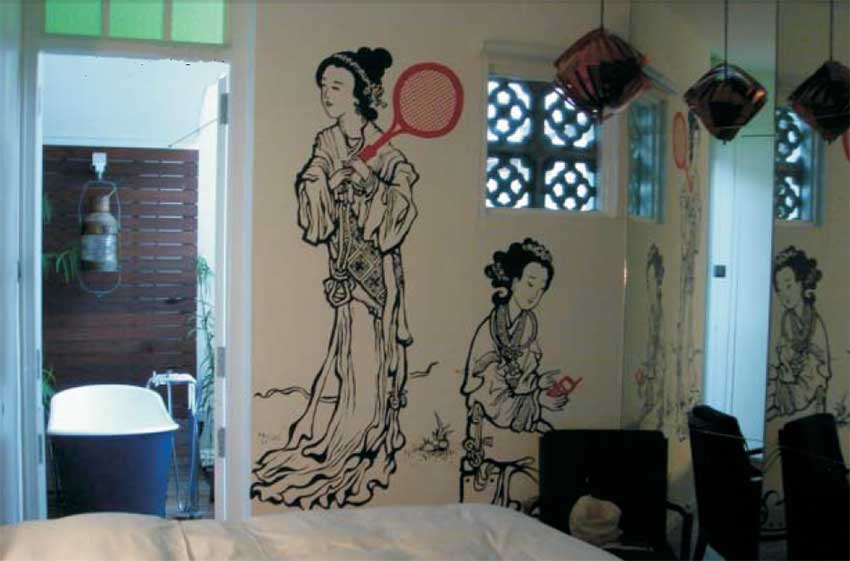
The hotel's original 50 rooms were brought down to 30 thus ensuring there was enough space and distinguishing features to make every room a statement. Another fascinating feature is the fixture of '1296', Lightouch Design Competition 2007 award-winning lights that adorn the lobby. These are light bulbs that are created with 1296 incised cuts in a two dimensional plane thus giving rise to an organic form, so the bulbs dance echoing through its layers. The New Majestic Hotel went on to win the Designs of the Year category in the President's Design Award 2006 and was also mentioned in the Condé Naste Traveller as one of the world's most hospitable hotels.

Oddfellows Hall Edinburgh
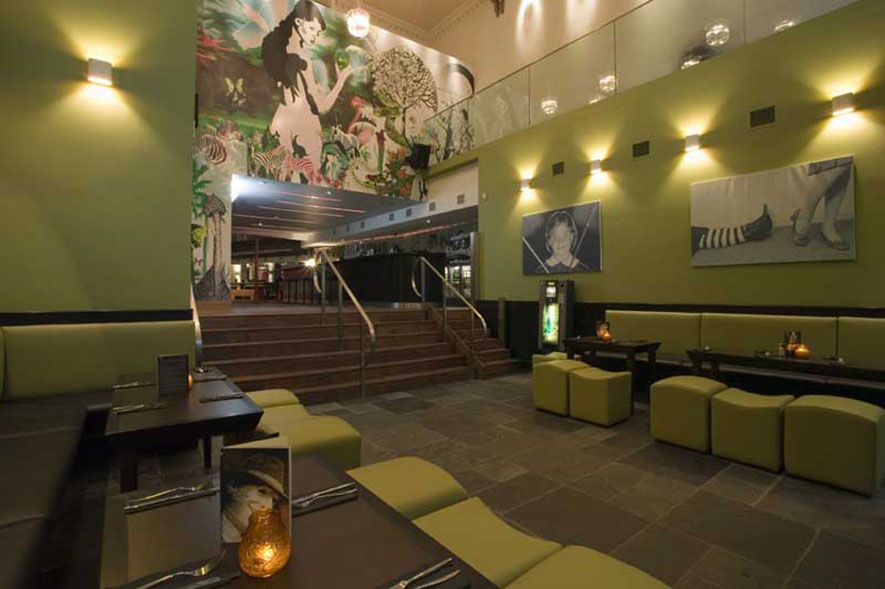
The Oddfellows Hall in Edinburgh's Old Town is an iconic bar/ pub in this city. This once traditional building has now been refurbished to give it a modern look. The clients, Festival Inns Ltd commissioned architects and designers Lee Boyd to give it a more contemporary appearance and interiors. With the building's double height space, the architects made sure that the building was visible enough from the road side thereby giving it a transparent look from one side. Also the paint was stripped so as to expose the magnificent stone façade of the building.
Trying to incorporate the old and new in the refurbishment, Lee Boyd also utilized the services of Grum Anderson and his company Dynamic Productions for the renovation of the main room of the building. Grum's specialized and technologically advanced lighting scheme was used here at the Oddfellows Hall.

Here, he has created a unique design that uses individual single source LEDs in fixtures customized and set into polycarbonate baroque light fittings to light the points of the vaulted ceiling. More light fixtures under the ventilation ducts throw light on the exposed brick wall, with lights slowly changing colors while rotating and each revolution taking almost an hour to complete and also setting up sculptural plywood moose heads to add some drama to the interiors. Lee Boyd also got a local artist Gregor Laird to design a double height artwork, Garden of Eden piece-Utopia that was put at the bar's entrance.
New additions in the Oddfellows Hall also included setting up a new public house with kitchen facilities on the ground floor and additional public space on the balconies above. Lee Boyd completed the refurbishment of Oddfellows Hall in December 2006 and the entire project cost £1 million. The interiors renovated led to the Hall bagging the Roses Design Awards 2007 for Best Interiors. This once traditional meeting place for members of the Oddfellows order has now been transformed into a hip joint and is now quite a landmark in this part of the country.
- http://www.leeboyd.com/oddfellows.htm
- http://www.nightmagazine.co.uk/venues/OddfellowsEdinburgh.htm
- http://www.edinburgharchitecture.co.uk/oddfellows_hall.htm

UNStudio’s Ardmore Residence in Singapore
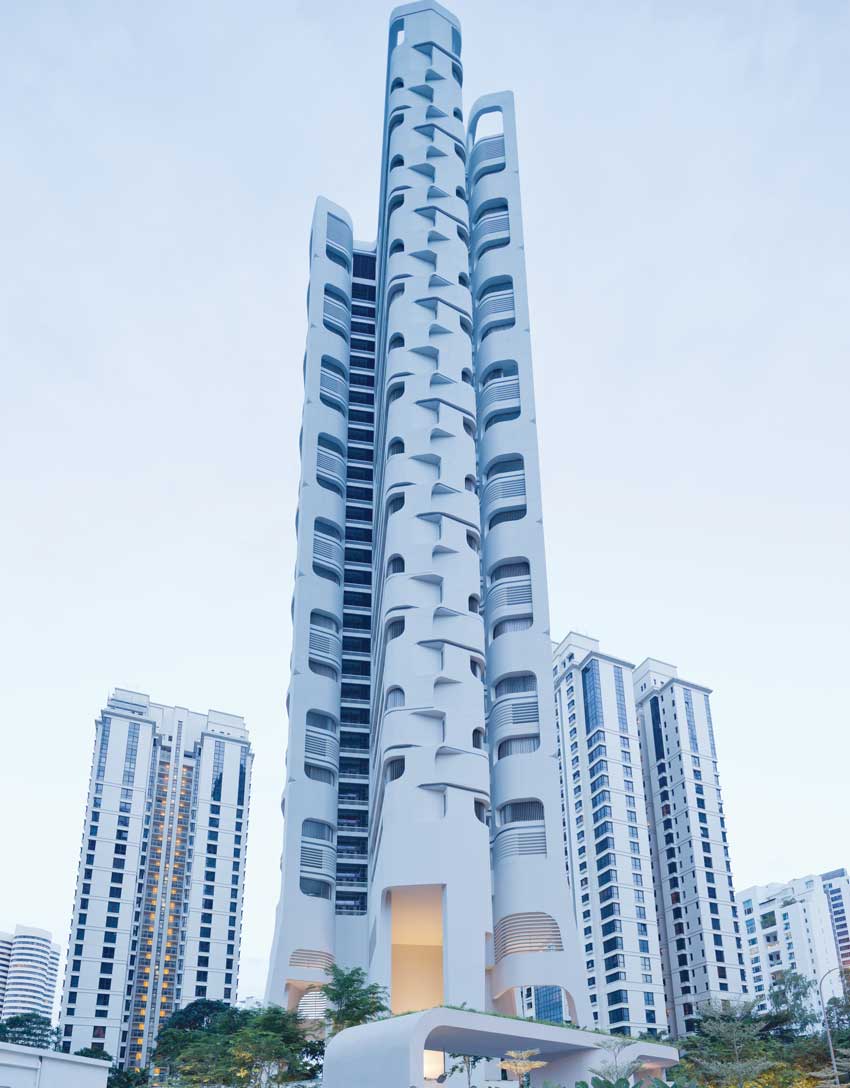 |
| Photo courtesy: Iwan Baan |
The Ardmore Residence at 7 Ardmore Park in Singapore is these new breed of residential towers. Situated in a prime location close to the Orchard Road luxury shopping district, the Ardmore Residence enjoys both expansive views of the panoramic cityscape of Singapore City and the vast green areas of its immediate western and eastern surroundings.
 |
| Photo courtesy: Iwan Baan |
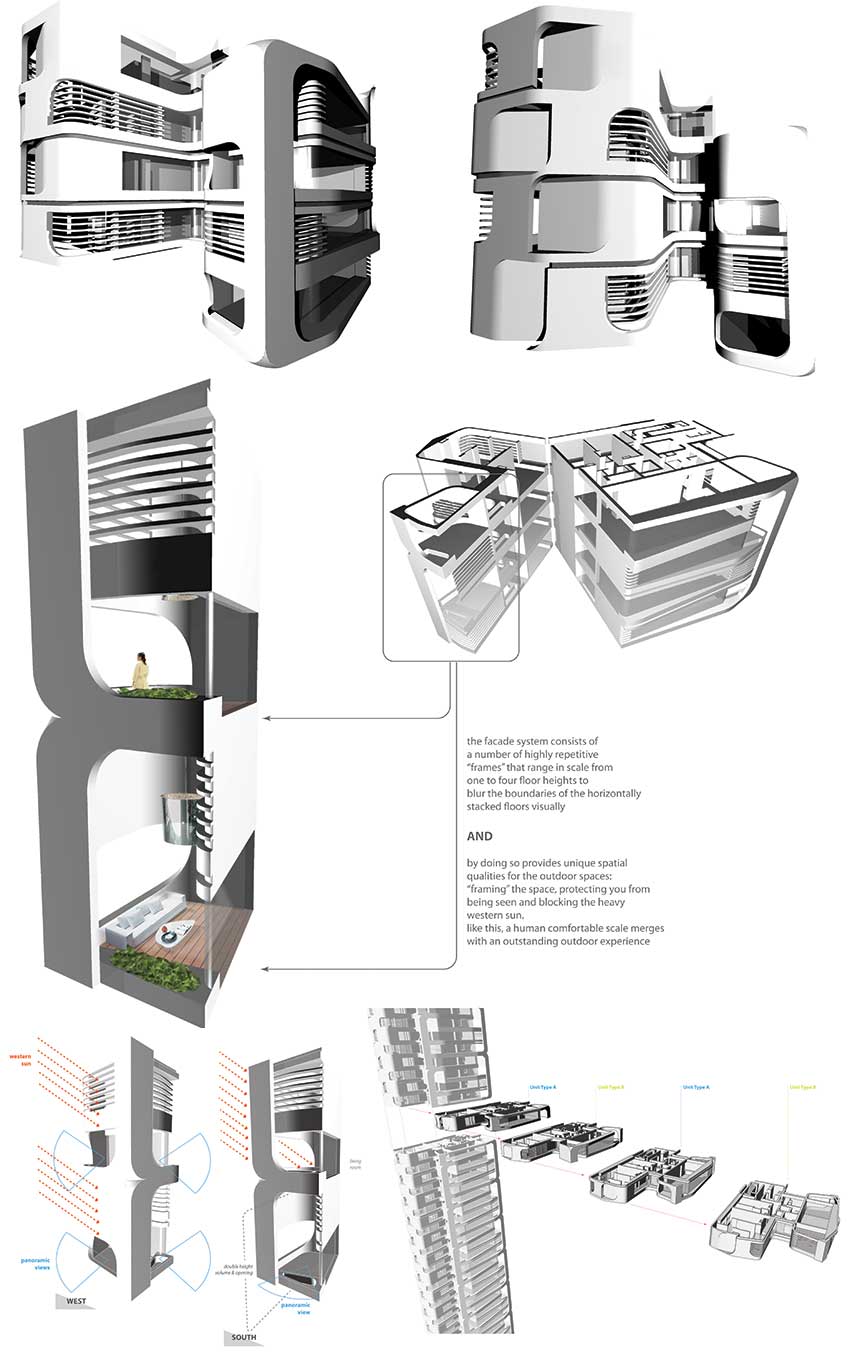 |
| Photo courtesy: Iwan Baan |
Living landscape
 |
| Photo courtesy: Iwan Baan |
Textured facade
 |
| Photo courtesy: Iwan Baan |
 |
| Photo courtesy: Iwan Baan |
Inside-outside landscape
The apartments in the Ardmore Residence embody the idea of a 'living landscape'. Functional spaces are redefined and extended into the living landscape concept, offering the possibility for versatile functionality for the occupants. An indoor-outdoor living experience is achieved through the inclusion of large windows and double height balconies in all of the residences. These elements enable a wide variety of views across Singapore City, while the large vertical balconies additionally offset the horizontality of more private interior spaces. With the terrace spaces integrated into everyday internal living scenarios, the living landscape promotes seamlessness between interior and exterior spaces. Bay window features on the façade create natural shading on the glass to minimize heat gain and provide welcome opportunity for planting by the residents.| Project Factsheet | |
| Architect | : Ben van Berkel / UNStudio |
| Interior design show suite | : Terry Hunziker |
| Location | : 7 Ardmore Park, Singapore |
| Programme | : Residential |
| Client | : Pontiac Land Group |
| Consultants | : |
| Mechanical & Electrical Consulting Engineers | : J Roger Preston, Singapore |
| Façade | : Ove Arup, Singapore |
| Design Year | : 2006 |
| Completion | : September 2013 |
| Contractors | : Shimizu Corporation |
| Interior design show suite (level 33) & clubhouse | : Terry Hunziger |
| Entrance artwork | : Yayoi Kusama |
| Building Information | |
| Site Dimensions | : 5.595 m² |
| Building Height | : approx.. 135.7m (Ground – FL 117.130. Top of Upper Roof – FL 252.830) |
| Number of Floors Below Grade | : 1 (one), Car park |
| Number of Floors Above Grade | : 36 storeys (lobby at ground level, 1st residential level at 8th storey) |
| Floor Area: |
|
| Exterior Materials | |
| Substructure | : concrete |
| Superstructure | : concrete |
| Envelope | : pre-fabricated concrete |
| Interior Materials / suppliers | |
|
|
| Furnishings | : (type and manufacturer) |
|
: Kitchen system by Poggenpohl from Germany Refrigerator and Wine chiller Liebherr from Germany Oven, Microwave, Cooker Hob & Hood, Dishwasher: V-zug from Switzerland Washing machine & dryer: V-zug from Switzerland |
|
: Sanitary ware: Kohler from USA |
|
Tap fittings: Dornbracht from Germany (note: Kitchen Yard is Jado from Germany) GIRA Switches and EIB Lighting system |
|
: Custom-made aluminum retractable louvers at the balconies |
| Sustainable features according to Greenmark Declaration |
|
 |
| Photo courtesy: Iwan Baan |
Continuous landscape
The first residential level of the Ardmore Residence is located on the eighth storey of the building. An open framework has therefore been introduced at the base of the raised tower which enables full connectivity and transparency across the ground level landscaping, while simultaneously organising the shared amenity facilities. Whilst building regulations in Singapore specify both the height and area of high-rise buildings, views are also deemed to be essential for the occupants. The raised design of the Ardmore Residence therefore integrally incorporates these set parameters to take full advantage of the potential. They afford to optimise the design concept and simultaneously create a fully integrated living and leisure landscape for its occupants.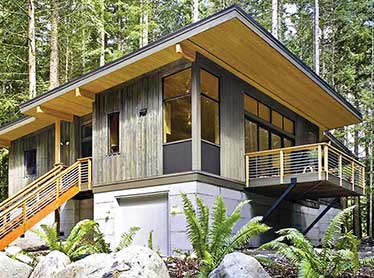
Eco-Tent Cottages

Presenting a Luxurious New Concept for Resorts, Retreats, and Beach huts- The Future of Multi-purpose Building options for the Hospitality Industry
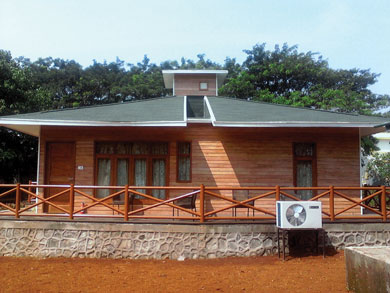
Loom Crafts' Eco-tent Cottages made to work in harmony with the environment; are architecturally designed, flexible in application, foster sustainability and able to maintain affordability. These luxurious eco-friendly cottages give a rare opportunity to those who are concerned for environment, but want to live in spacious luxury surrounded by canvas, wood and all other modern day amenities that the cosmopolitan life has to offer.
"Simple enough for anyone to assemble yet robust enough to withstand extremes of external conditions and weather"
The revolutionary design of these Eco-tent Cottages is based around a robust aero-space grade aluminum framework, which forms the core structure of the modular building, a virtually indestructible grid of aluminum and stainless steel. Each interlocking square panels are fastened to adjoining sections by a patented locking system designed to withstand enormous pressure. The top of the tent is made of fire retardant tensile PVC coated fabric membrane which lasts for years without any maintenance.

"These cottages are of five-star living standards with unlimited choices wherein the interiors can be changed unlimitedly."
Once the basic grid floor plan is in place, the interior living or working environment can be created from an extensive selection of ancillary modules. Packed with eco-amenities such as solar power, natural ventilation, cloakroom and bathtub, among others, the wooden deck flooring along with aluminum doors and windows powder coated in a choice of colors further adds to the plush interior designs and premium finish. All Loom Crafts Eco-Tent Cottages have insulation on top and sides thereby making them suitable for air conditioning. In addition, the elevated wooden deck flooring further ensures negligible impact on the ground.
Whether creating a high-tech beach resort cottage, Safari style tents, eco-tent cottage or any other prefab structure, the Loom Crafts Eco-Tent Cottages are limited only by the imagination. So go ahead IMAGINE THE FUTURE!
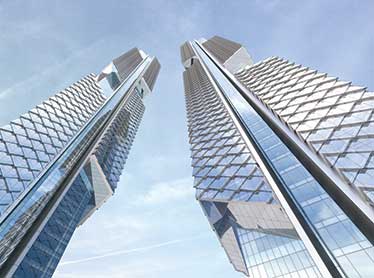
A Marvelous Tower Complex for Seoul's Yongsan International Business District
Dancing Dragons

Chicago based firm Adrian Smith + Gordon Gill Architecture which is dedicated to the design of high-performance architecture in a wide range of typology and scale, from low-and mid-rise residential, commercial and cultural buildings to mixed-use supertall towers and new cities, have designed a pair of landmark supertall mixed-use towers 'Dancing Dragons' for the new Yongsan International Business District in Seoul, South Korea. The buildings which include residential, "officetel" and retail elements, consist of slender, sharply angled mini-towers cantilevered around a central core. The design aesthetic is highly contemporary yet informed by aspects of traditional Korean culture.
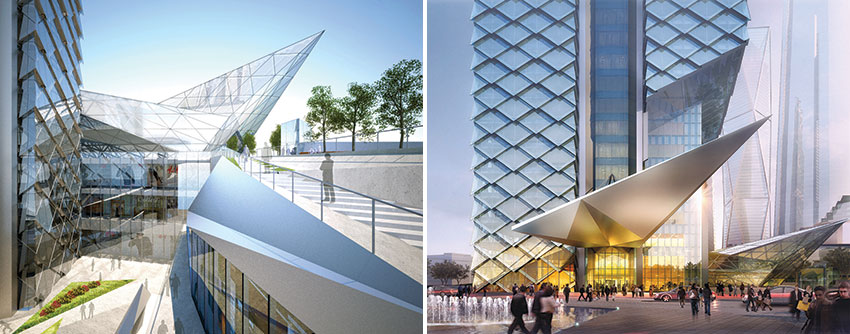
Positioned side by side in the fast-growing business and commercial district on the north bank of the Han River, the two Dancing Dragon towers have a similar design comprises a supporting central core and a series of wings attached to the sides. The mini towers feature a dramatic series of diagonal massing cuts that create living spaces that float beyond the structure. This recalls the eaves of traditional Korean temples—a design theme echoed both in the geometry of the building skin and the jutting canopies at the towers' base. The theme is extended in the building skin that suggests the scales of Korean mythical dragons, which seem to dance around the core—hence the project's name. (Yongsan, the name of the overall development, means "Dragon Hill" in Korean.)
Dancing Dragons' scale-like skin is also a performative element. Gaps between its overlapping panels feature operable 600-mm vents through which air can circulate, making the skin "breathable" like that of certain animals.
Towers 1 and 2—about 450 meters and 390 meters tall, respectively—share an architectural language and, therefore, a close family resemblance, but are not identical. In the taller structure, the 88-level Tower 1, the massing cuts at the top and bottom of the mini-towers are V-shaped. In the 77-level Tower 2, the cuts move diagonally in a single unbroken line; they are also arranged in a radial pattern around the core that is perceptible as viewers move around the tower.
| Project | : Dancing Dragons |
| Location | : Seoul, Korea |
| Function | : Mixed-use |
| Design Architect | : Adrian Smith and Gordon Gill |
| Client | : Yongsan International Business District |
| Photo credit | : All images ©Adrian Smith + Gordon Gill Architecture |
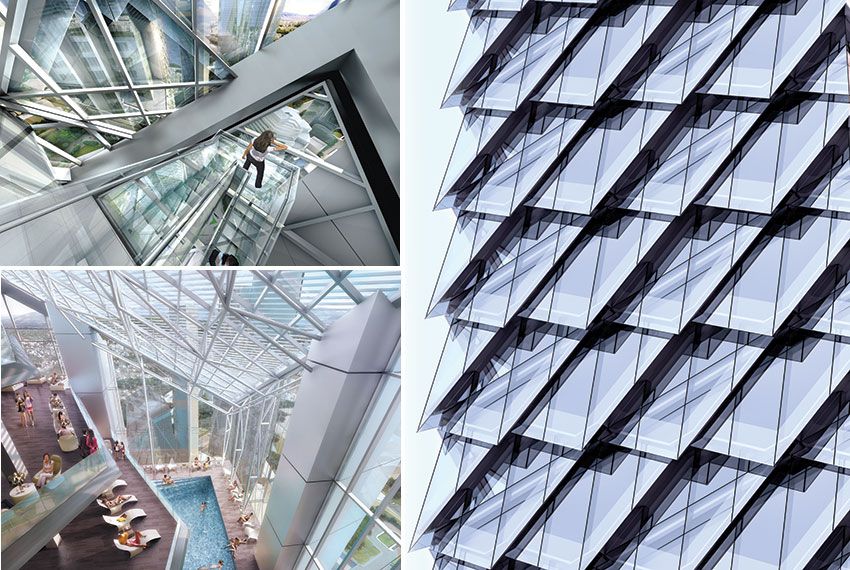
"There's a sympathetic and complementary relationship between the two masses at the level of the cuts, almost as though they were dancing," says Adrian Smith, FAIA, RIBA.
He further adds, "It's always important for our designs to reflect and interpret the cultures they serve, and the Dancing Dragons complex certainly does that, although in an abstract and highly technological manner. We try to design in a way that is at once beautiful and focused on performance."
In both buildings, the mini-tower cuts are clad in glass at the top and bottom, making for dramatic skylights above the units at the highest levels and a transparent floor beneath the units at the lowest levels. This offers the opportunity for special high-value penthouse duplex units with spectacular 360-degree views of downtown Seoul and the adjacent Han River, along with an abundance of natural light.
"The abstract recall of the historic structures gives the towers a unique perspective from the ground and the sky while creating unique interior experiences. The shingled texture of the skin is developed with integrated breathable mullions and self-shading cantilevers. It's a great honor to be joining several other top international architecture firms designing buildings for this remarkable master plan by Studio Daniel Libeskind," says Gordon Gill, AIA.
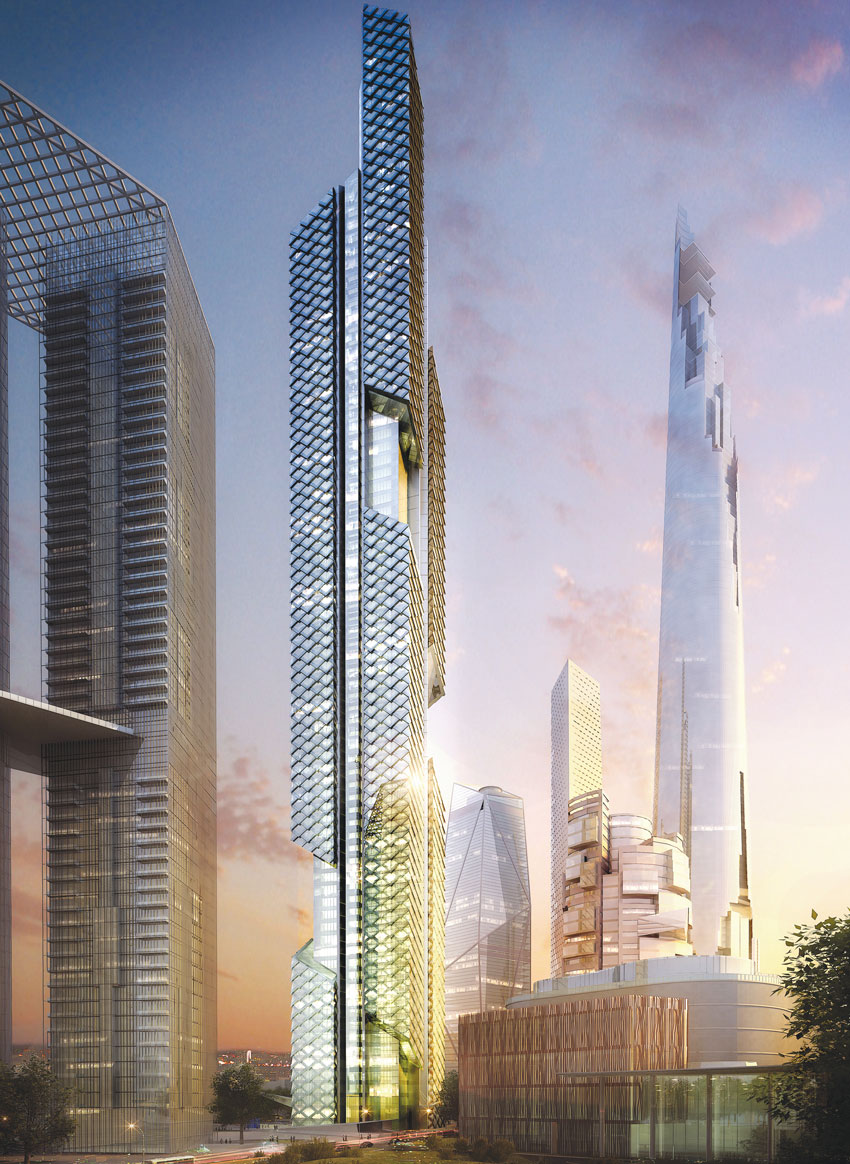
AS+GG partner Robert Forest, AIA, notes that Dancing Dragons represents AS+GG's second major project in downtown Seoul. The other is the Head Office of the Federation of Korean Industries, an innovative and highly sustainable office building now under construction and scheduled to be completed next year. "We're very excited to be making a sustainable contribution to the built environment of Seoul, one of the world's great cities, in a manner that addresses the need for sustainable high density development while respecting Korean culture," Forest says. "YIBD, which promises to become one of Seoul's most dynamic and vital neighborhoods, will be an example of high-quality high-density design, and we're proud to be a part of that."
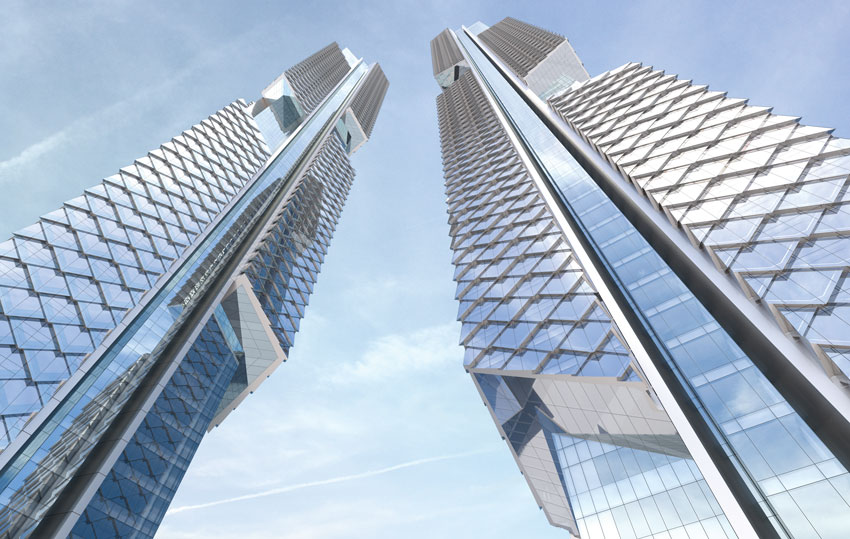
The design team also includes PositivEnergy Practice, a Chicago-based engineering and energy consulting firm that is designing a series of innovative building systems for the project. Sustainable features of the building system design include triple-glazed window units, which minimize heat loss; an overlapping exterior wall system, which creates a self-shading effect; and natural ventilation in all units through operable mullions. Other systems include radiant heating; fuel-cell cogeneration units at the basement level; photovoltaic arrays on the roof surfaces; daylight-linked lighting controls; and heat recovery via electric centrifugal chillers.
The structural scheme for Dancing Dragons, developed by AS+GG in collaboration with the international structural engineering firm Werner Sobek, features eight mega-columns that traverse the vertical length of both cores. The mini-towers are hung off the cruciform cores in a balanced fashion by means of a belt truss system, stabilizing the structure.
The design of the 23,000-square-meter site—part of the larger Yongsan master plan —reinforces the angular geometry of the building massing and skin. Landscape features, designed in collaboration with Martha Schwartz Partners, include sloped berms that echo that geometry. The site also includes a retail podium with a crystalline sculptural form and sunken garden that provide access to a large below-grade retail complex.
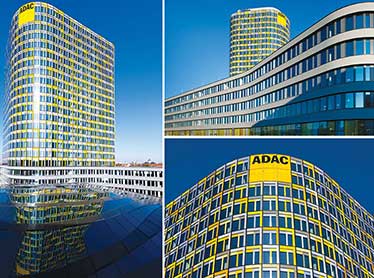
ADAC Headquarters- An Eye-catcher in Munich’s skyline

The 92 m tower with its over 1,000 windows in 22 different colours and the curved base construction is a new landmark of the Munich Westend.
| Credits | |
| Building owner | : ADAC e.V. |
| Architects | : Sauerbruch Hutton Architekten, Berlin |
| Structural planning | : Werner Sobek, Stuttgart |
| Façade builder | : Josef Gartner GmbH, EG-Fassade: Korsche |
| Screen print, roof glazing | : SGT, Oelsnitz |
| Screen print, façade glazing | : BGT, Bretten |
| Glass processor | : Interpane Plattling |
On a gross floor area of 129,500 square metres, the employees from all branches of the company – insurance, financial services, car rental, travel and cellular phone offers – work in an atmosphere marked by architectural openness. The Board and the management are on the two top floors; under them are cubicle areas and single office spaces, as well as large conference rooms at the centre of each level, all the way down to the ground floor. There, the employees can find a cafeteria, a casino, training rooms, the printing facilities, the kitchens, the mailing centre and the packing room.
From the outset, the owner wanted to create a building that would make its mark on the Munich skyline and host an innovative and state-of-the-art work environment. ADAC had also insisted to the architect for giving special emphasis on a state-of-the-art energy concept built on solar and geothermal energy as well as remote heat. Hence, the heating in building is based both on geothermal resources and on remote heat and most of the electrical supply comes from regenerative sources and solar panels installed on the rooftops. Apart from them, the architectural marvel also features natural ventilation inside the offices through the double-layered façade.
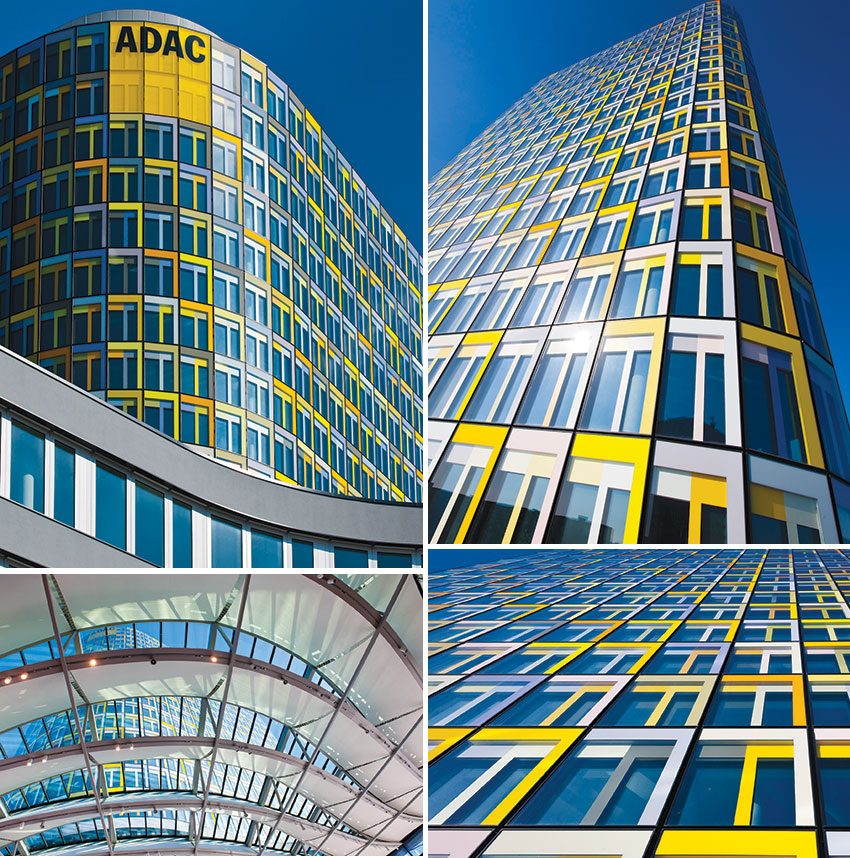
Light-flooded foyer
A central foyer serves both as a representative lobby and as the central distribution point for all employees; from here they can reach their offices in the five-storey low-rise block or the eighteen storey tower above it via escalators and lifts. It has something of the feeling of a gigantic train station: the glass roof floods every corner with light and offers a view onto the façade of the office tower, which is over 92 metres high. The tower boldly overhangs the base by eight metres in the direction of the nearby train tracks. To prevent the foyer from overheating despite the large proportion of glass, ipasol platin 25/15 solar control glass from Interpane is used. It has a solar factor of 15%, guaranteeing effective protection from the sun's heat. This significantly reduces the air conditioning requirements. At tV = 25%, the daylight transmission is also low, which prevents glare when the sun is high in the sky. To comply with the stringent safety requirements, the insulating glazing on the roof consists of an outer layer of single-pane safety glass with heat-soak test (ESG-H) and an inner layer of laminated safety glazing (VSG). Some of the outer panes also have a screen print.
Facades
The requirements for the façades of the base and the highrise block included letting a lot of daylight into the building while maintaining good solar control and thermal insulation. The architects designed a laminated window façade with insulating glass on the inside. On the outside, in front of the insulating glass, lies single-pane glazing with a screen print finish. This ensures continuous rear ventilation. The window openings can be operated by hand, but a volume flow control system in front of them regulates the airflow. Coloured profiles and partial screen print design make the building shimmer in 22 different colours. The insulation glazing ensures an optimal interior climate by using ipasol neutral 70/39 solar control glass and iplus E-thermal insulation glass from Interpane. ipasol neutral fulfils high aesthetic and functional requirements: colour-neutral transparency, lots of daylight and high solar control. The solar control glass achieves a particularly high daylight transmission of tV = 70%, with a solar factor of 39%. On cold days, the Ug-value of 1.1 W/(m²K) (according to EN 673) ensures effective thermal insulation. The energy requirements for heating, cooling and artificial lighting are thereby reduced – which lowers the operating costs and is good for the environment.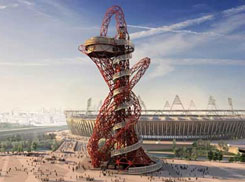
The ArcelorMittal Orbit- The Tallest Sculpture in U.K.
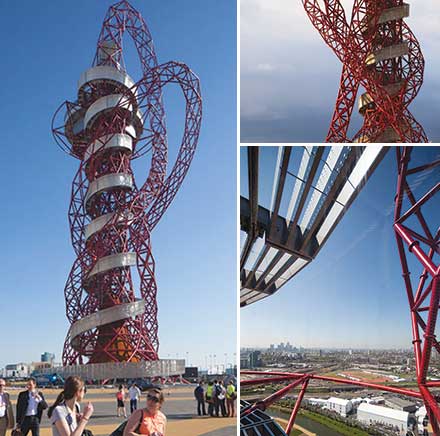 |
| Figure 1: The ArcelorMittal Orbit |
The Orbit has two observation floors, a 455-step spiral staircase, a lift and restaurant. At ground level, visitors are greeted by a massive steel horn which hangs overhead. The uppermost observation floor is flanked by two concave mirrors which disorientate the visitor before they get to see the skyline beyond. Visitors will be able to go up the 35-storey structure in a lift. At 114.5, the Orbit gives panoramic views across London's skyline of up to 20 miles. After their visit is over, visitors have the option to descend via the 455 steps that were designed to make the visitors feel as if they were orbiting around the structure. The exterior of the structure is outfitted with 250 colored spotlights. Each can be individually controlled to produce a stunning digital combination of static and animated effects including a 15 minute moving light show every evening after the Games.
Creation of unusual structure
The design was the winning entry to a competition launched by Mr Boris Johnson, the Mayor of London. He wanted to create "something extra" to celebrate London Olympics 2012, which would "arouse the curiosity and wonder of Londoners and visitors." Designers were asked for ideas for an "Olympic tower" at least 100 m high, and Orbit was the unanimous choice from proposals considered by a nine-person advisory panel. From the initial sketch, it has grown into a looping lattice form. The lattice evolved from the need to build the vision and make the concept constructible. Kapoor and Balmond's idea was to 'challenge the idea of tower', so initially it was just a vertical form. It is stabilized by points crossing in space on a tripod base. Daniel Bosia of Arup engineered the overall form.| Figure 2: Comparison of heights of iconic sculptures (Source: http://www.e-architect.co.uk) |
Structure of Orbit
The structure of Orbit consists of the following three parts (see Fig. 1):- The central tower, which houses the elevators and stairs and supports the observation deck.
- The open lattice of red steel that surrounds the trunk (Fig.3).
- The external helical stair
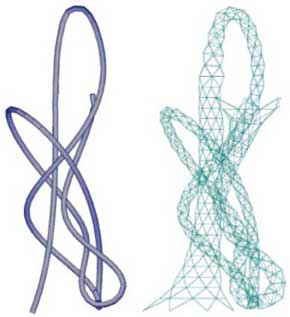 |
| Figure 3: (a) Concept and (b) actual structure of looping steel lattice around the central tower (van Velzen, 2012) |
A special part of the construction is the canopy, the conic shape that hangs off the bottom of the trunk. Originally, it was planned as a fiberglass composite construction. Consideration of cost resulted in the use of steel for this section also. Centraalstaal International, Netherlands was approached as a special consultant for the design of the steel cone and came up with a design for a cone built out of 117 individually shaped steel panels with a total surface area of 586 m2 and weighing 84 tonnes (van Velzen, 2012).
Creators of the ArcelorMittal Orbit
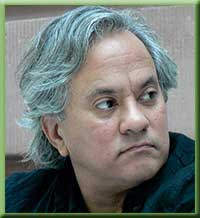
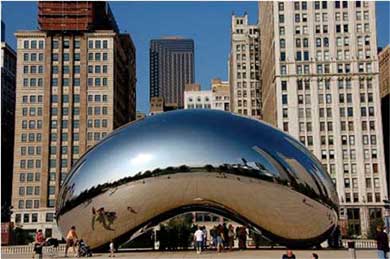 |
| Anish Kapoor And Cloud Gate in Chicago’s Millennium Park |
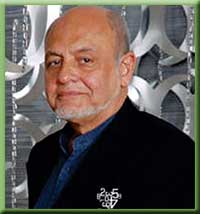
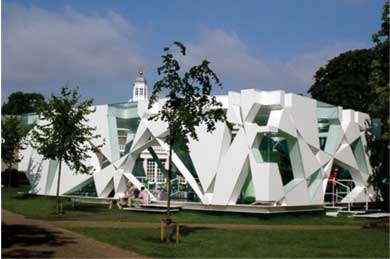
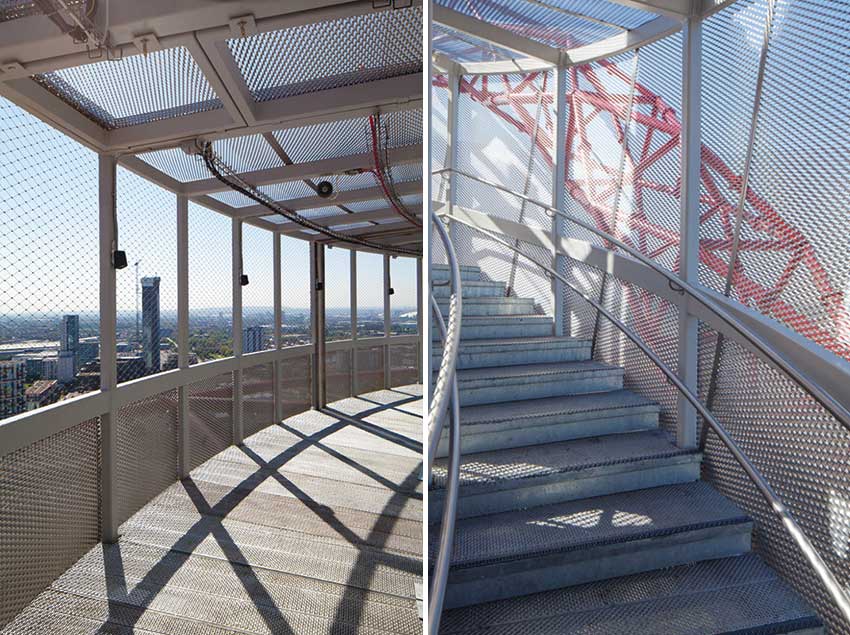
Using steel as a sustainable material
Construction of the ArcelorMittal Orbit took 18 months and required 560 m of tubular steel to form the sculpture's lattice superstructure. A four-man team assembled it together, comprising two steel erectors, a crane operator and a site foreman. All of the junctions between the big red bits of steelwork are wild, with unpredictable shapes and members coming in all directions. The result is a bold statement of public art. It is important to note that the tower is both permanent and sustainable, with close to 60% of the 2,000 tonnes of steel used, coming from recycled sources (harnessed from every continent where ArcelorMittal has operations). This tower cum sculpture underlines steel's status as the world's most recyclable material. Steel was chosen for the Orbit because of its unique properties including strength, modular structure, and advantages of weight, speed of construction, and recyclability.Some Highlights about ArcelorMittal Orbit
- Tallest sculpture in the U.K.
- Standing at 115 m, it is 22 m taller than the Statue of Liberty in New York.
- If the loops around it are flattened out and the tower is made vertical, it will be taller than Eiffel tower in Paris.
- Provides unparalleled views of the entire 250 acres of the Olympic Park and London's skyline from a special viewing platform.
- Over 35,000 bolts and 19,000 liters of red paint were used in its construction.
- Designed by Artist Anish Kapoor and Cecil Balmond
- Architects : M/s Ushida Findlay Architects
- ArcelorMittal donated $ 30.7 million and 2000 tons of steel to create it.
Public Opinion about the Orbit
Cecil Balmond said that he and Anish were conscious from the beginning that the ArcelorMittal Orbit would be a lasting legacy to the city and so they wanted to stretch the language of the icon as far they could go. The Orbit is a hybrid, a network of art and structure, and its dynamic is the non-linear. You read into it multiple narratives in space." Towers are almost always symmetrical," he continued, saying the Orbit's twisted loops were "the refusal of a singular image". Kapoor and Balmond believe that Orbit represents a radical advance in the architectural field of combining sculpture and structural engineering, and that it combines both stability, and instability in a work that visitors can engage with and experience via an incorporated spiral walkway.The design of the Orbit has split opinions since its inception at a chance meeting between London Mayor Boris Johnson and steel magnate Lakshmi Mittal in a cloakroom at the 2009 World Economic Forum in Davos. Critics have described the orbit as "the Eiffel Tower after a nuclear attack" and "a catastrophic collision between two cranes." Oliver Wainwright, from Building Design magazine branded it "a contorted mass of entrails". He objected the way it towers over the stadium, saying that the 2,000-tonne structure compared unfavourably to the lightweight construction of the venues in the Olympic park.
Funding
ArcelorMittal, the sponsor of the tower and the Olympics, is a leading steel manufacturer and provided the material for the sculpture.It provided £19.2m towards the cost of building the Orbit, with the remaining £3.1m was funded by London Development Agency.
The tower is expected to attract 1 million visitors per year to Stratford's Olympic Park, when it reopens as the Queen Elizabeth Olympic Park after the Games. During the Games, the ticket price is fixed as £15 for adults and £7 for children.
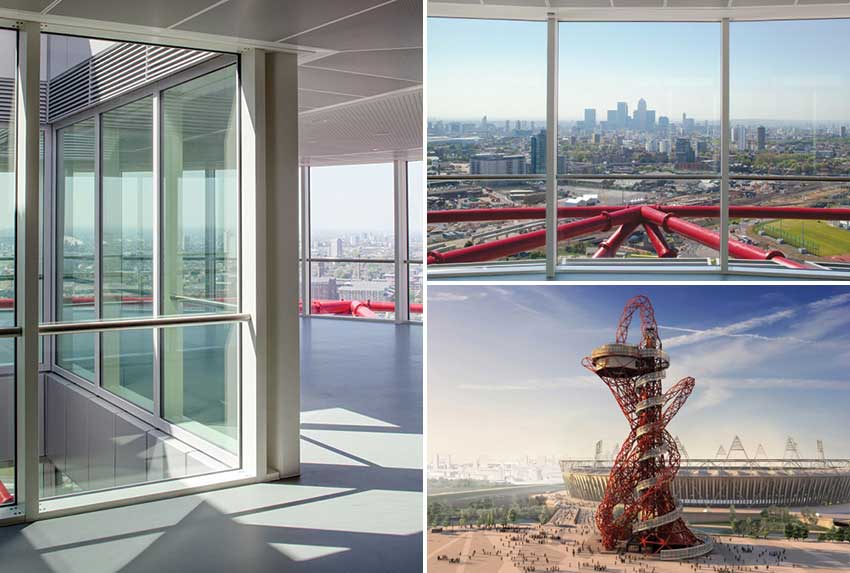
About ArcelorMittal
ArcelorMittal is the world's leading steel and mining company. Guided by a philosophy to produce safe, sustainable steel, it is the leading supplier of quality steel products in all major markets including automotive, construction, household appliances and packaging. ArcelorMittal operates in 60 countries and employs about 260,000 people worldwide. Mr. Lakshmi Niwas Mittal (born on 15th June 1950), is the Chairman & CEO of ArcelorMittal and was ranked the sixth richest person in the world by Forbes in 2011. In 2009, ArcelorMittal had revenues of $65.1 billion and crude steel production of 73.2 million tonnes, representing approximately 8 per cent of world steel output.Future
Eiffel Tower was built as a temporary structure and erected in 1889 as the entrance arch to the 1889 World's Fair. Although, Eiffel Tower was hated by most Parisians and the design was criticized by many at that time, it has now become a global and cultural icon of Paris. One of the most recognizable structures in the world, this tower is the tallest structure in Paris and the most-visited paid monument in the world (7.1 million people ascended it in 2011). Similarly, will the Orbit be acclaimed as the cultural icon of London? Only time can provide the answer!References:
- http://www.london.gov.uk/priorities/art-culture/culture-2012/arcelormittal-orbit
- Meinhold, B., "Anish Kapoor's Recycled Steel ArcelorMittal Orbit Tower Provides Views of London's Olympic Park", Inhabitat - Sustainable Design Innovation, 26th July 2012. (http://inhabitat.com/anish-kapoors-recycled-steel-arcelormittal-orbit-tower-now-complete-in-london/arcelormittal-orbit-anish-kapoor-1/?extend=1 Accessed Aug. 1st 2012)
- http://www.anishkapoor.com/
- http://www.arcelormittalorbit.com/orbits-journey/perspectives/cecil-balmond
- http://en.wikipedia.org/wiki/ArcelorMittal_Orbit
- Oh, S., Cool Olympic Tower, Modern Steel Construction, Vol.52, No. 8, Aug. 2012, pp. 38-39.
- van Velzen, T., Rood icoon (Red icon), (in Dutch). De Ingenieur, Vol. 124, No.10/11, June. 2012, pp. 25-27.
- http://en.wikipedia.org/wiki/ArcelorMittal_Orbit
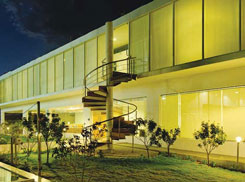
Fratelli Wines Industrial Project Solapur, Maharashtra

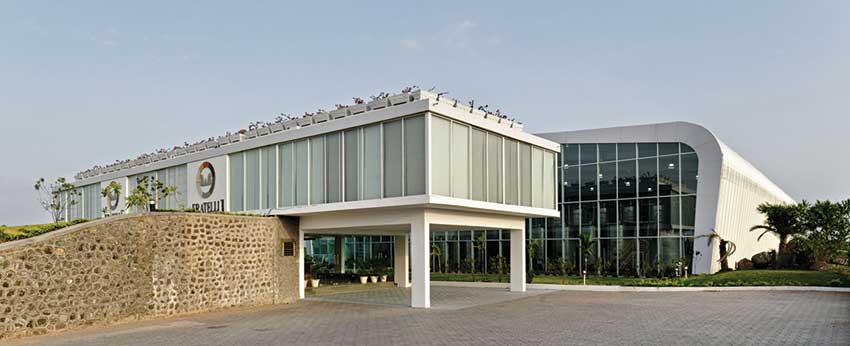

Wine making has invariably been a fascinating process. India lacks the culture of wine drinking - the reason why the country has a minimal presence of vineyards in the country - restricted to a mere 6-7 in numbers. When the reputed winemaking Italian Company Fratelli Wines Pvt Ltd approached Architect Sunil Patil to design their winery unit in Solapur, the uniqueness in the assignment was what appealed to Mr Patil to explore the process of wine making thoroughly. Architect Sunil Patil heads his seventeen years old award winning firm Sunil Patil & Associates in Kolhapur and is known for his patented 'Tropical Contemporary Vernacular Architecture'. Believing in an architecture that is built in harmony with nature, Architect Patil likes to create spaces which require minimum intervention with nature.
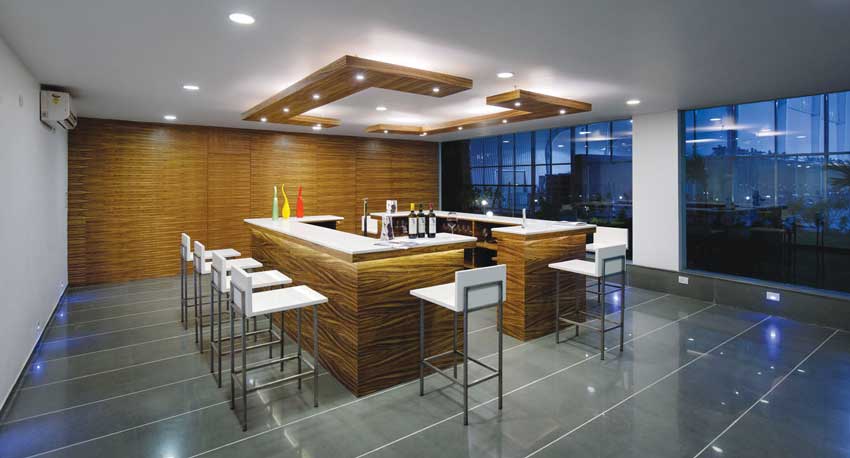
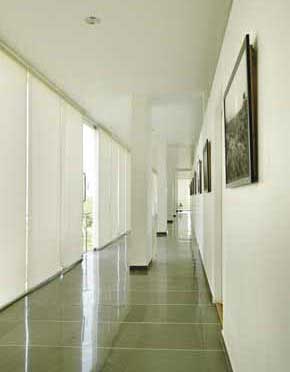
The huge existing 40 acres of vineyard in the provided site took care of the first step – the harvesting while the brief for the remaining steps included a winery plant with processing units, bottling plant and a tank hall which would be required to give a huge output of 9 lakhs litres of wine annually, probably one of the biggest winery plants in the country as Mr Patil adds. Besides, a cellar and an administration block (with wine testing lab) completed the brief. The entire design was conceived as two surface blocks (segregated through landscaping) serving as the admin and processing unit while a cellar was conceived in the basement. With a built up area of 2500sqm on a plot area of 11,501 sqm, the project got completed in Dec 2009.
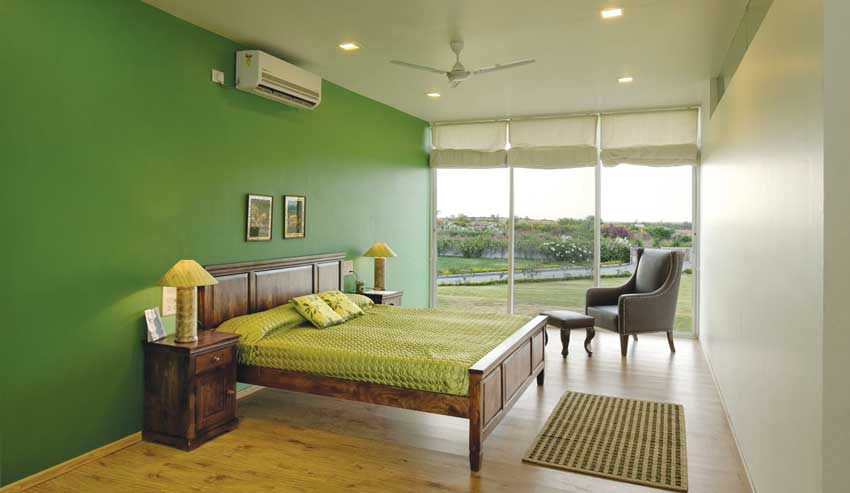
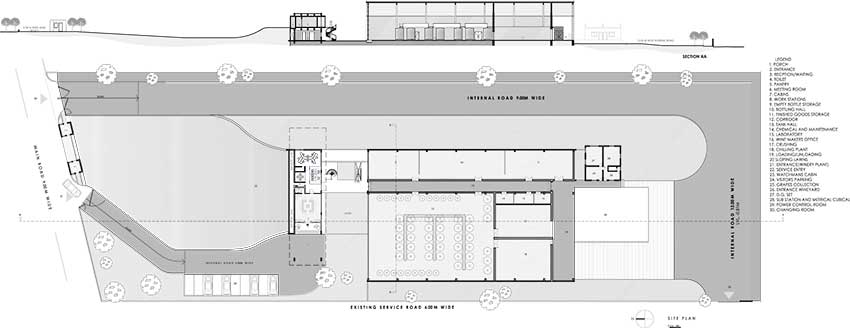

Design
The main gate throws open the views of the admin block sitting on a huge mount scape in surrounding lush landscaping behind which lies the processing plant. The G+1 admin block has wine tasting and accounts department (on the ground level) and a wine tasting lounge (projecting out in the vineyard) and guestrooms (for the company executives) on the first floor. The lounge offers vantage views of the vineyard on one side and the wine making process on the other side. The guest rooms in varying coloured themes of red, yellow and blue bear expansive views of the lawns through full length glasses and are complemented by old styled furniture which are inspired from the process of making wine which is again age old.

The spiral staircase going to the first floor in this block provides a certain break to the rigid geometry besides the mound which are the only two features punctuating the calm. Another staircase leading down to the cellar (designed parallel to the processing plant unit) is deftly camouflaged by an interesting surface door. The site undulations led to the soil being removed to create the cellar which has been used for the mount scape. The cellar used for storing the finished wines into different vessels (to made ready for bottling or further ageing) required no direct sunlight and hence a brief of no windows. However, Mr Patil's yearning of windows led him to implement his experience of orienting the glass façade of the processing plant to the north where the sun would never enter directly. Mr Patil informs that the executives were keen on following the European concept where a drum of wine is handed to the winery when a child is born which is eventually handed back to the child by the winery when he/she gets married. This gave birth to the huge 241sqm cellar.
Avoiding any complex structural materials, the processing unit made in steel portals with aluminum frames takes care of all the intermediate steps involved in making wines and has units for crushing, fermentation and filtration. The process of wine making needs a minimum temperature and hence the north glazing was made the lone recipient of the sun's rays while all the other sides were blocked from sunlight.
Sustainability
Architect Patil who believes in environment-friendly sustainable architecture, made use of the same stipulated mud for the mount scape that was extracted to make the cellar. By this he could evade the cost and the time that would have been required in the disposing of the mud. Its innovative implementation here bestows a more vernacular look to the project where the built space seems to be borne out of the mound.The 23m of linear space in the processing unit has been supported by small and straight steel trusses made by I sections. A very delicate design has been conceived where the same section becomes the wall and the ceiling (roof of the structure). The PEB's for the same were manufactured in Delhi and conferred a very neat and clean appearance from inside, found rarely in such industrial projects.

Simple materials have been used – Kota Stone, Ceramic Tiles, exposed Trimix Concrete for the flooring of the Admin Block, Bottling unit and plant room respectively. The exterior façade is finished in restrained amounts of glass and concrete.
The architect has successfully confronted the challenges of a regimented budget, the newness of this kind of a project, the intricate planning of areas like the tank hall and the location of the site in a remote area of Maharashtra where transportation posed to be a challenge. The simplicity of the project lends a certain sense of unexpected calm through the site. Practically accepting nature as his guide, Ar Patil has added his own vernacular touch to this modest design.
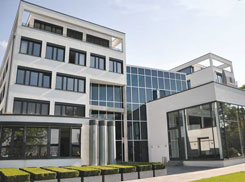
House of Architects Energetically Modernized with "Sunglasses"

The "House of Architects" in Stuttgart is a forum for building culture and the headquarters of the Chamber of Architects of Baden-Württemberg. The glazed foyer has just been completely modernized. Some pane edges had become leaky and the glass had become fogged by condensation between the panes. The glazing was also far below current energetic standards. The sun blinds, which were on the inside, required constant maintenance and blocked the view. The complex requirements for the modernization were to lower the heating and cooling costs, improve the lighting, and provide a clear, glare-free view, unobstructed by shading. The owners opted for electrochromic triple-pane solar control glass from EControl in Plauen, Germany. It is dimmable, thus allowing the solar factor and transparency to be modified according to the level of solar irradiation. This makes both exterior shading and interior blinds redundant.
The House of Architects in Stuttgart is situated in an exposed, elevated location and offers exceptional views of Stuttgart. More than two decades ago the owner, the architects' pension fund, bought a plot neighbouring their existing premises and held a competition for the new building. Architect Michael Weindel (Waldbronn) designed and built the ensemble of three structures: living quarters, event hall and administration building. The round event hall stands as a special construction in the middle and is attached to the administration building by a transparent and filigree glazed foyer, thus preserving the grandiose view of the Stuttgart skyline from Danneckerstraße.
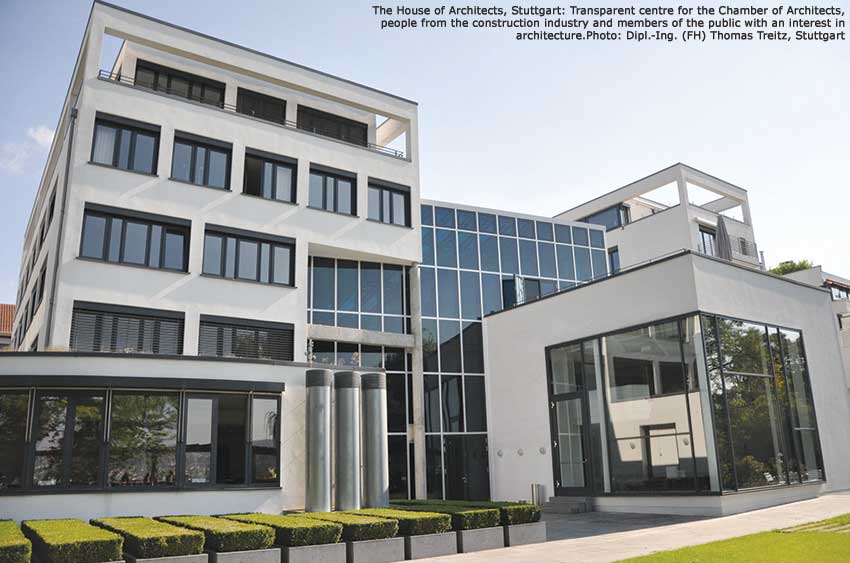
| Credits board | |
| Architektenkammer Baden-Württemberg, Stuttgart | |
| Object address | : Danneckerstraße 54, 70182 Stuttgart |
| Building owner | : Versorgungswerk der Architekten, Stuttgart |
| Architect | : Dipl.-Ing. Michael Pauls, Stuttgart |
| Façade construction | : Aug. Guttendörfer GmbH & Co. KG, Stahlstraße 8,91522 Ansbach |
| Glass product | : EControl |
| Glass production | : EControl-Glas, Plauen |
Leaks and water: renovation required
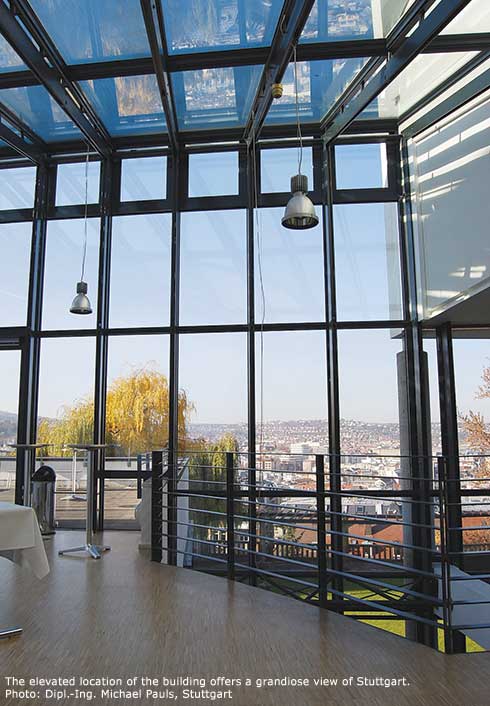
The architects' office Pauls (Stuttgart) won the contract to modernize the glazed foyer. The aims: maintain the architecture, increase the comfort and reduce the energy costs to a moderate level. Exterior shading and interior blinds were both rejected in favour of maintaining an unhindered view to the outside. Traditional solar control glass, with a low but constant solar factor, was not considered because it lets in too little light on cloudy days.
Intelligent solution: dimmable solar control
After weighing up the parameters, the architect suggested electrochromic solar control glass (EControl). Dimmable panes allow the solar factor and the transparency to be adapted to the actual light intensity. "If there is no sun, the glass stays fully clear and transparent. The stronger the sun shines, the darker the glass becomes, all the way to a deep blue – like photochromic ski goggles," explains Dipl.-Ing. Michael Pauls, architect and owner of the architects' office. Photochromic sunglasses make additional eye protection unnecessary and don't tire the eyes; they adapt to the light intensity. The dimmable solar control glass EControl carries this principle over to modern architecture with its electrochromic technology. A modern triple-pane insulation glass, EControl insulates extremely well against heat loss with a Ug value of 0.7 W/(m2K).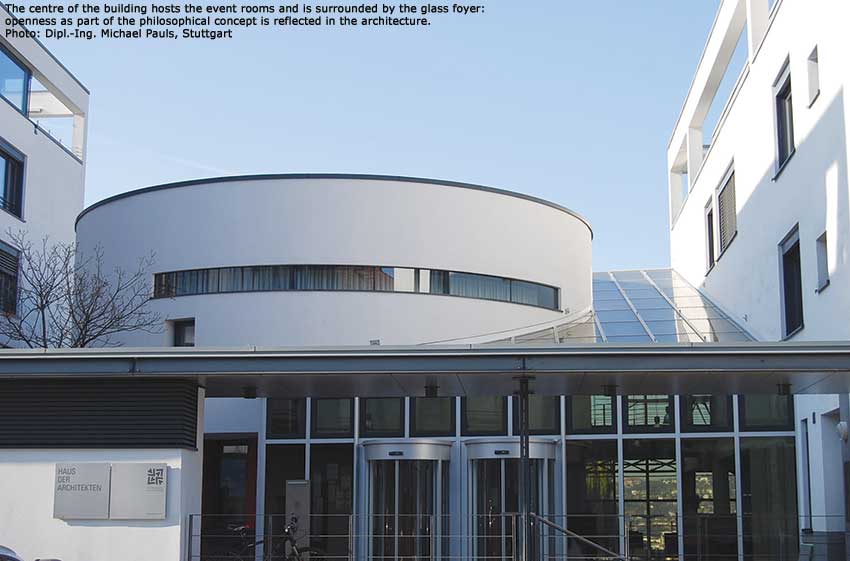
The complete renovation was carried out in only twelve weeks in the summer of 2011 by the façade construction company Guttendörfer (Ansbach) – whilst limited operations at the House of Architects forum continued – and was completed in the autumn.
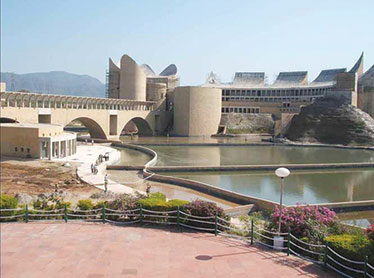
Khalsa Heritage Centre - A Mammoth Museum
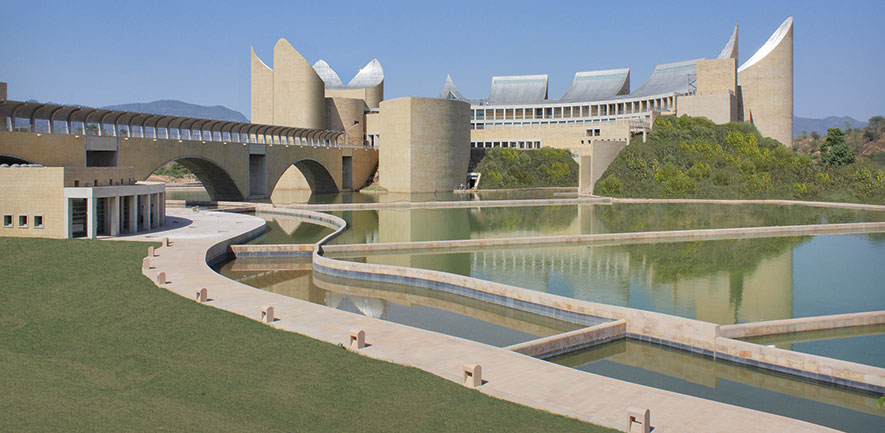
The Virasat-e-Khalsa Heritage Centre, a mammoth museum chronicling Sikh history was recently inaugurated in the land of Sikh warriors, Anandpur Sahib by Chief Minister of Punjab in the presence of Boston-based designer of the complex, Moshe Safdie, who is known for creating the famous Holocaust Memorial Museum in Jerusalem.
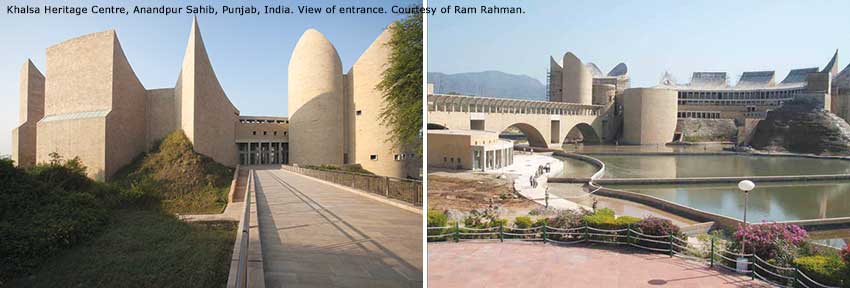
The classy complex, which is expected to draw international attention, has come up in rugged surroundings but with water bodies of extraordinary beauty, and reflect the surrounding hillocks, lend the complex an astonishing degree of serenity. Sprawl over 65-acre, the complex is deeply rooted in its surrounding landscape and resonating with regional architecture, seemingly rises from nearby sand cliffs. Clad with local sandstone and evoking the fortress cities of Rajasthan, Gwalior and Punjab, the Centre acknowledges the Sikhs' history as celebrated warriors. The upwardly curving roofs of the museum's tower-like galleries are covered in stainless steel, designed in counterpoint to the rich tradition of gold domes that crown sacred Sikh buildings as the Golden Temple in Amritsar. The project is said to be the largest contemporary heritage complex ever conceived in India and provides a delightful audio-visual experience unlike anything one has seen in Indian museums.
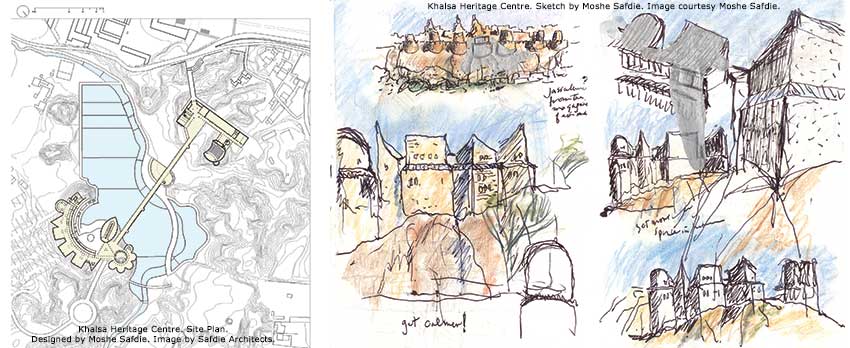
The museum campus is composed of two functionally integrated sets of buildings. The western complex, forming a gateway to Anandpur Sahib, houses exhibition galleries; a two-level library centered around a grand reading room overlooks water garden; a facility for storing rare archival materials and a 400-seat auditorium. A 540-foot bridge from the western complex crossed a seven-acre network of reflecting pools, providing access to the eastern complex which houses permanent exhibitions presenting Sikh history, religion, and culture.
Arranged in group of five, the galleries reference the five virtues of Sikh religion. The symbolic themes of earth and sky, mass and lightness and depth and ascension are represented by the museum's sandstone towers and reflective silver roofs and are further echoed inside the museum's galleries.
The delightful experience begins at the Boat-shaped building 'Punj Paani' - the first gallery depicting the past and the present of Punjab, as seen in its villages and towns. The inside walls of the towering boat-shaped building have multiple colourful panels to create a three-dimensional effect, every inch hand-painted to perfection. The building also houses the largest hand-painted mural in the world, which uses a staggering 24,000 metres of fibre optics to illuminate it to depict Diwali.

As one will walk through the ramp encircling 'Punj Paani, he will find that with the help of sound, music and other visual manipulations, the entire cycle of a year is recreated within a span of just eight minutes. The vibrant colors then give way to a subdued, star studded night with a tower of light at the centre, which symbolizes the emergence of 'Ek Onkar', illuminated, pure and eternal. From here begins the journey of the evolution of the Panth with the birth of Guru Nanak Dev. The experience is enriched by the auto-trigger audio guides, available in English, Hindi and Punjabi. 'Auto-trigger' implies that as you walk into any gallery and the audio guide plays content specific to the area. In the 'Five Crescent Building', the tone and tenor of the colors and sound becomes more militant and depict the struggle and sacrifices made by the last five Gurus to establish the Panth.
The 15 galleries which are completed so far out of 25, cover an area of 650,000 square feet. Ten more will be completed subsequently. The second phase of the complex, for which work is still going on, is expected to show the growth of Khalsa over the last 300 years, culminating in the partition of Punjab.

Safdie and his associate architect, Ashok Dhawan of New Delhi, worked closely with the exhibition designer, Amardeep Belh of Design Habit in New Delhi, to achieve a successful integration of architecture and display. According to the interior designer of the building, Mr. Amardeep Behl, "It took us almost three and half years to complete the interiors which include paintings, murals and around 400 artist were involved in it including designers."
Moshe Safdie was commissioned to design the Khalsa Heritage Centre in 1997, after the chief minister of the Punjab visited the Children's Holocaust Memorial at Yad Vashem, the Safdie-designed Holocaust memorial in Jerusalem. As the Centre evolved, Safdie was able to renew a long, close relationship with India that had begun in the 1960s with his work on Louis Kahn's Indian Institute of Management school at Ahmedabad, Gujarat.
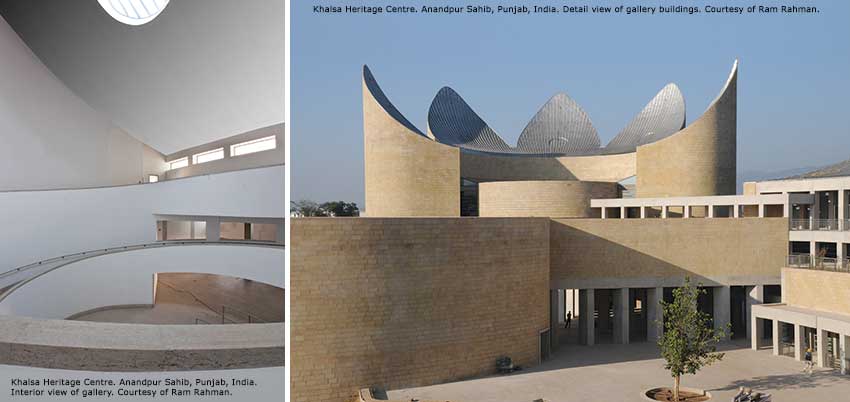
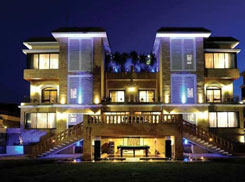
Della Enclave-A destination that Redefines Luxury

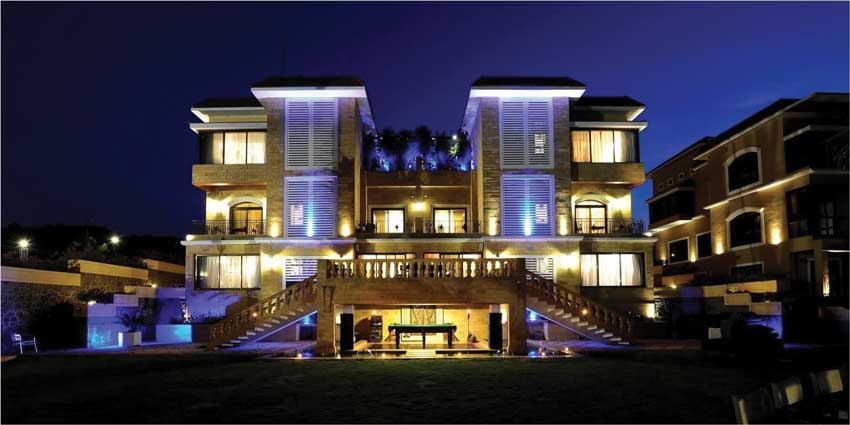
Catering to the trend of hi-end living and the demand for second homes, Architectural and interior design consultancy firm Della Tecnica, has ventured into constructing luxurious villas for those who values spending time in the lap of serenity, peace and environmental beauty.
Nestled amidst the lush green mountains of Lonavala, Della Enclave is a destination that redefines luxury. Consisting of 46 beautiful Mediterranean and Contemporary style villas (Phase I & Phase II) spread over 24 acres of the breathtaking landscape, the project gives a global living experience, where modern luxuries and amenities are in perfect synergy with untouched natural serenity. Only 3.2 Kms from the Mumbai-Pune Expressway, these villas are ideally located to insulate one from the bustle of city life, while maintaining easy connectivity at the same time. It is a perfect getaway for those who are looking for quiet times in the lap of natural surroundings. The unique benefit that owners of villas at Della Enclave can avail is the availability of developed infrastructure.


The complex boasts amenities like a modern and fully equipped gymnasium, spa, salon, swimming pool, beautiful landscaped lawn, to name a few. The villas and complex are both built according to the instructions of Vaastu Shastra, infusing positive energy in ones homes and lives.
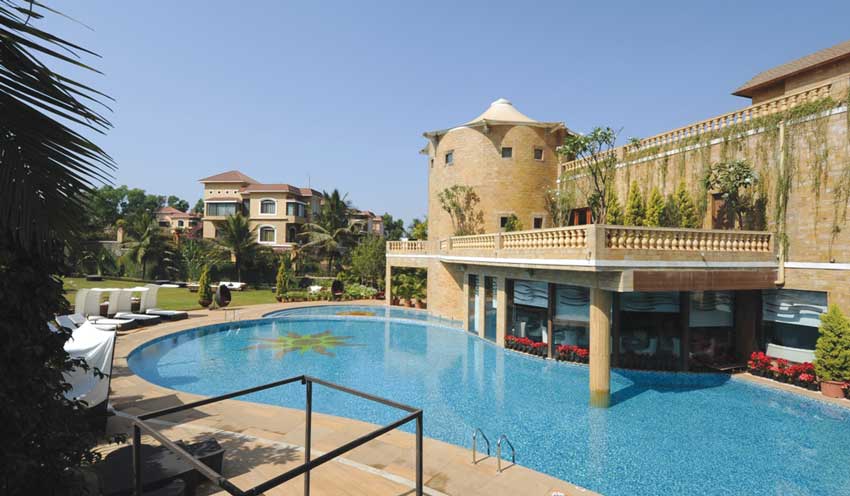
The project boasts of facilities like broadband, Wi-Fi Internet, House-keeping, visitors car parking, 24/7 security with CCTV, 24/7 Hydro Pneumatic water supply and uninterrupted electricity with DG Backup are provided in addition to all other facilities as that of a 5 Star resort. Besides, business centre and lounge, ambulance at site and doctor on call is also available. The complex also comprises banquets, golf range, 4 restaurants and bars. The project is an eco-friendly and supports rainwater harvesting, Installation of STP, low voltage cabling, saves electricity and ecological paints and materials and ample landscaping.
So let Della Enclave enchant one with its charming architecture, world class services and amenities, and breathtaking surroundings; an oasis of luxury and scenic beauty. The Della Enclave complex also consists of Della Adventure – Asia's largest Adventure Park and Resort.
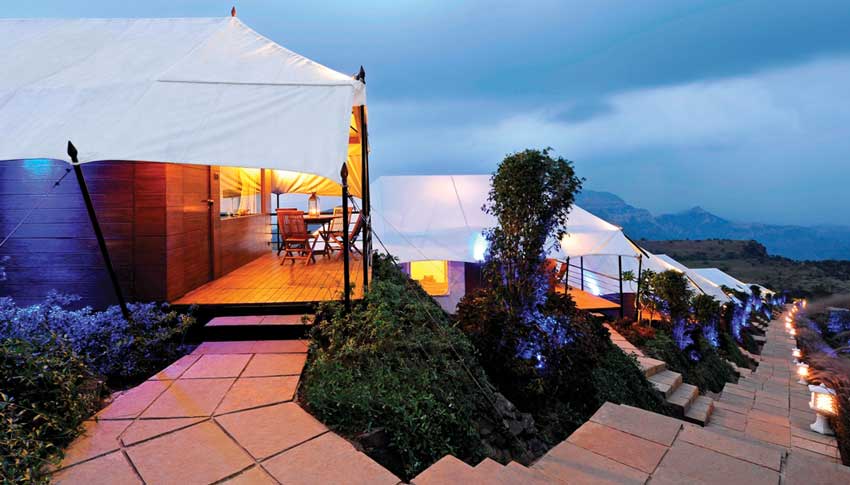
After successful completion of first phase consisting of 24 villas, Della Tecnica has launched second phase of Della Enclave, Signature Villas which will consist of 22 villas develop on 5000 sqft of plot with 3500 sqft carpet area. The concept of second homes is now more than just affordable houses in the outskirts of the city. Second homes are now a reason to relax, and spend time with family.
Announcing the second phase of Della Enclave Mr. Jimmy Mistry, Chairman and Managing Director of Della Tecnica, said, "We are glad to note that today's Indian customer have a developed taste for fine living and are looking for out of the world concepts in architecture and designing. They are increasingly asking for stylish holiday homes to own, which is definitely encouraging. Della Enclave villas within the project area boasts of India's largest adventure park, a 5 star-resort with swimming pool and spa facility and a banquet hall. The concept has been developed after a good deal of research and insight into the emerging demands of Indian home buyers."

After investing Rs.250 crore in the Lonavala project, the company also plans to set up villa projects in five cities in next three years with an investment of around Rs.1,500 crore. "After receiving an encouraging response to our villa project in Lonavala in Pune, we are now planning to set up five more in major cities like Bangalore, National Capital Region (NCR), Kolkata, Indore and Ahmedabad in next three years," said Mr. Mistry.
The Mumbai-headquartered firm, which has launched a villa project along with an adventure park and resort in Lonavala, will fund these projects with a mix of debt and equity. "While 30% of the fund will be through equity, rest 70% will be raised through debt," he said.
Referring to listing plans, he said the company is not in a hurry to list as it will wait till a certain scale is attained in the revenue front in the near future.
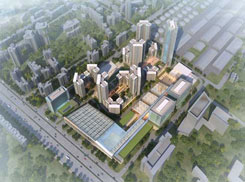
CCPL’s Rivali Park
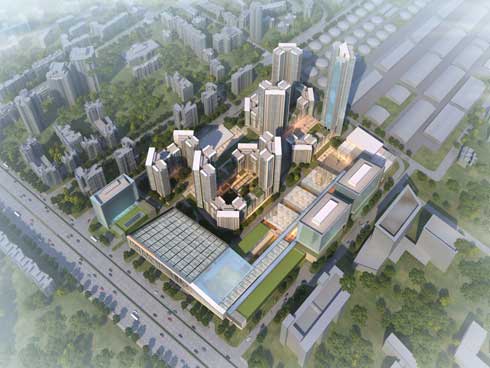
The project plans fulfil all the criteria for "Leadership in Energy and Environmental Design" (LEED) certification. A residential complex has been designed in 4 clusters that offer a mix of low and high-rise towers. Each building has been oriented to catch the breeze and minimize heat waves. Each flat will have at least 2 exposures to the outside. The shorter buildings will have sky gardens, so that the view is always verdant from any observation point. Each cluster will have an individual courtyard with seating nooks and walking paths. Ample 3-level parking will be available. The ground level will be a vehicle-free pedestrian podium, offering a high degree of safety to the young and old alike. Extensive traffic studies are being conducted to avoid vehicular and noise pollution.
Vision and Creation
Talking about the Project Mr. Harjith Bubber, CEO & MD, CCI Projects Pvt Ltd said we had a simple vision to transform the property so that it mirrored the lifestyle of South Mumbai. A hardcore South Mumbaikar, his ethos resonated with the culture of the island city. Our team of architects at Gensler conceived of Rivali Park to make his dream a reality. Our aim was to create a plan with an intelligent design and a social conscience.Elaborating on the plan creation he said, Architecture is about people. Rivali Park – named after Borivali, where it is located – is a project that focuses more on planning than building. After all, buildings are mere containers that hold people. We wanted to create something beyond brick and mortar, an integrated residential, commercial and entertainment hub that would assert its identity and make the suburb a landmark. The Rivali Park design combines sophistication with self-sufficiency.
The project began with a comparative study of the suburbs and downtown Mumbai. What we observed is that the suburbs have grown out of a need to accommodate the surging masses that have been thronging to Mumbai since independence. Their growth is rapid and imposed, favouring functionality rather than aesthetics. Suburban residential colonies are blocks of residential apartments where people come home to their families after a day of work in the city. This is in contrast to the downtown area, where maidans, academic edifices, shopping plazas and residential buildings all co-exist side by side. South Mumbai continues to represent the social and cultural hub of the city, retaining its rich old world charm with its mingled spaces and narrow paved alleys.
Challenges
The biggest challenge in planning Rivali Park was the perception that suburban residences and commercial buildings cannot be mixed too closely in high value properties. The Mumbai psyche subconsciously classifies each suburb by its location, demographic mix, proximity to major landmarks and availability of amenities. Each suburb adds its unique flavour to the melting pot. People have become used to segregated spaces in the suburbs. That is simply how life is; there's just no time to ponder over anything else. The young, upcoming suburbanite may travel to South Mumbai daily for work and study, and maybe even visit a theatre or art gallery occasionally, but home will always be a 60 minute commute away. We had to convince the mindset that residences can maintain a high quality even when they are located alongside commercial, art and entertainment units. Gensler's global experience of individual mixed-use components that attract people and create market power enabled us to take on this challenge.The key to Rivali Park is much more planning than architecture per se. It envisages an upwardly mobile, cosmopolitan community of about 50,000 people with extensive opportunities for social and cultural interaction within their own backyard. The focus is on creating gathering spaces for the people. Technically known as "negative spaces", these are the spaces between the buildings. Most projects focus only on the "positive spaces" that are actually inhabited. We see negative space as a very important and active feature of community life. To create a constant but varied mix of people, we conceived of a shopping mall opening onto a retail street. The mall is a very important element that will help generate retail mass.
The nearest performing arts space is Prithvi Theatre at Juhu. The large population inhabiting the stretch beyond Andheri needs something that they can call their own. The Rivali Park retail street will culminate in a public plaza and performing arts building. The public spaces will include shops, cafeterias, a hotel and office buildings. These spaces will be open to all. The Rivali residential buildings will be nestled within the 'L' of this arrangement. The complex is flanked on two sides by the Kanakia Residential and Commercial properties.
Residential Quarters
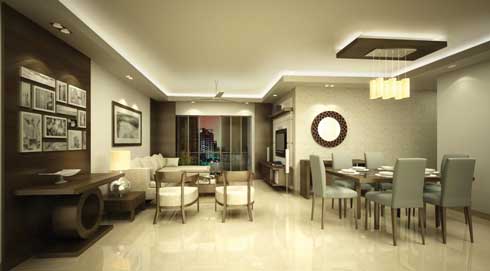
A flat slab structure is being considered for the apartments to give the occupants flexibility to plan their own interiors. Each building will have a separate fire exit, as per norms. Ramps will be constructed on the ground floor to facilitate movement of physically challenged individuals and senior citizens.
External Façade
The architecture will be clean, rational and modern, pleasing to the eye outside the building and comfortable for the people living inside. The design has to be true to the building material, which in India is RCC. We have attempted to lighten the heavy look of RCC by using glass and screens. The buildings will be oriented so that the apartments are protected from heat waves. Each flat will have at least 2 exposures to the outside to bring about cross ventilation. The shorter buildings will have sky gardens, so that the view is always verdant from any observation point.Traffic Management
Extensive traffic studies of the area have been carried out by Eigen. The entire residential complex has been conceptualized on a vehicle-free pedestrian podium, offering a high degree of safety to the young and old alike. In order to keep the ground level alive in the residential area, the drop-off points have been very carefully thought out. Full use will be made of the existing service road and two side roads that are already in place. The traffic management plan deals with all levels and curves in the side roads to ensure the smooth passage of vehicles. Traffic will circulate around the podium. RTO chowkies and traffic islands are an important necessity in any good locality and will be considered once permissions are obtained.Car Parking
The complex will have space to accommodate 4000 cars. Ample 3-level parking will be available. Totally underground in the retail and commercial spaces and mostly underground with a small portion at street level in the residential complex.Talking in length on the project he summed up by saying, Rivali Park offers artistic and creative individuals an outlet for expression. Its public spaces will bring in a new mix of people everyday, converting an erstwhile drab suburb into a cultural hub. The comfortable living quarters with a mix of levels, the open spaces against the backdrop of the Sanjay Gandhi National Park and the retail and commercial facilities will together transform the location into a comfortable haven where every amenity will be in close proximity. Situated off the Western Express Highway, minutes away from Borivali Railway Station, the residents of Rivali Park will experience the best of Maximum City.
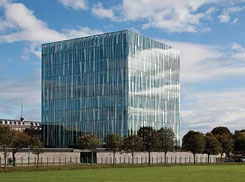
University of Aberdeen New Library Scotland

The University of Aberdeen has recently opened the doors of its new library to students and public. Designed by Danish architects schmidt hammer lassen (SHL) to provide a 21st century learning and research environment to students, university staff, and visitors, the library is envisaged as a cube evoking the ice and light of the north.
The new library serves a community of 14,000 students. The 15,500 square metres of floor-space accommodates 1,200 reading spaces alongside archives, historical collections and a rare books reading room. It has also traditional silent study rooms to interactive areas for collaborative projects, supported by information technology. The entire building has comprehensive wireless network coverage with sockets to plug in your PC throughout.
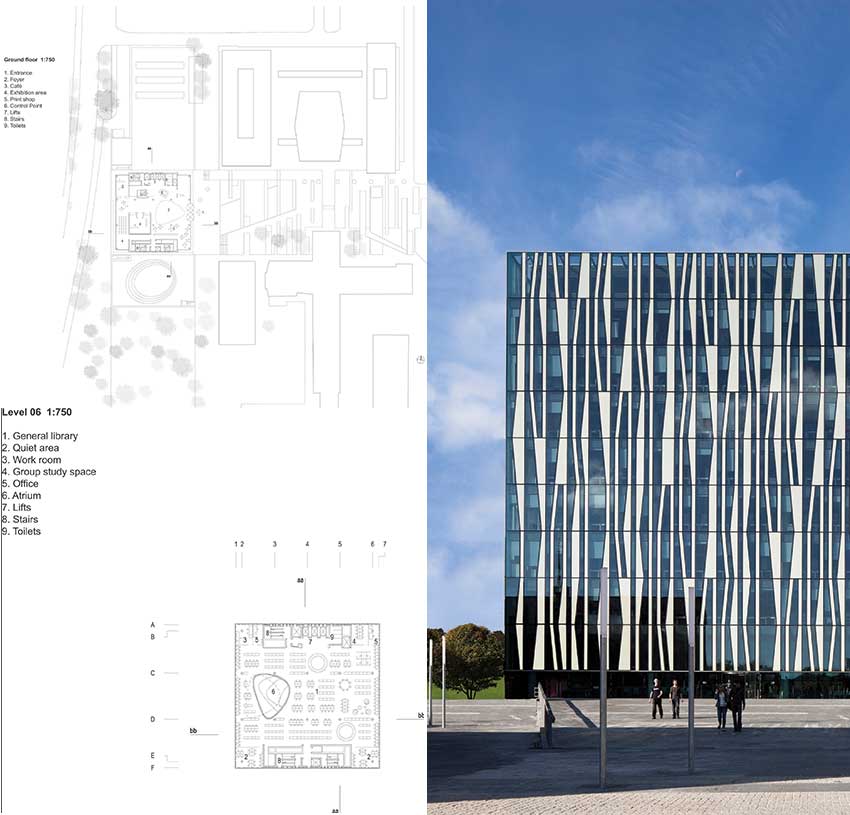
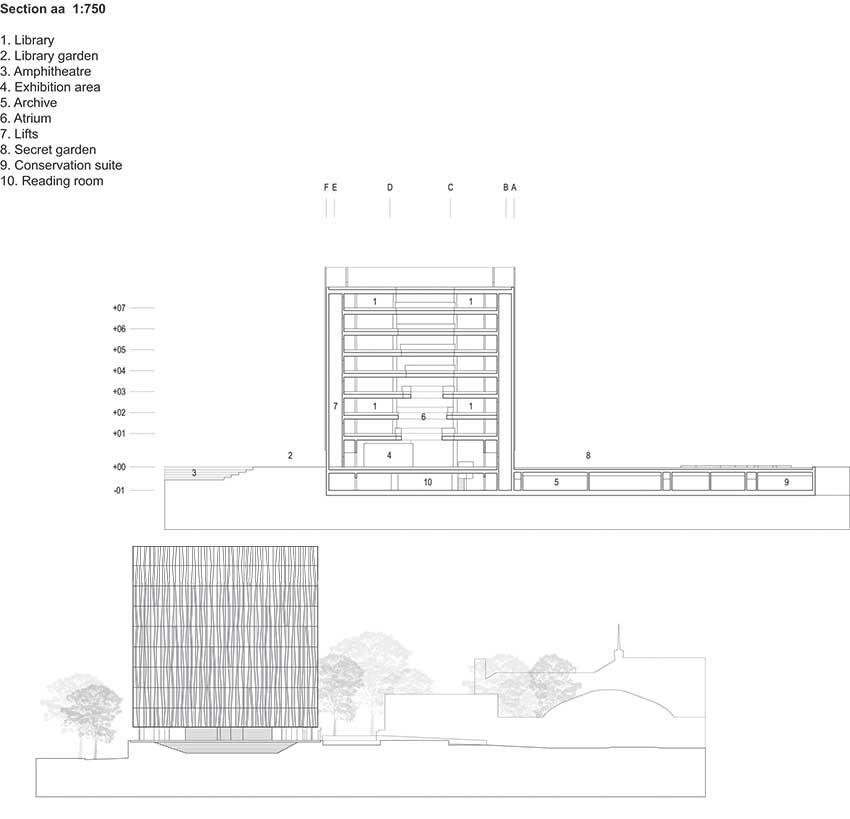
| Project at a Glance | |
| Project | : University of Aberdeen New Library |
| Architect | : schmidt hammer lassen architects |
| Location | : Aberdeen |
| Client | : University of Aberdeen |
| Completed | : September 2011 |
| Area | : 15,500 m² |
| Competition | : 2005, 1st prize in restricted international competition |
| Engineer | : Arup & Partners Ltd |
| Quantity Surveyors | : Davis Langdon LLP |
| Landscape Architect | : schmidt hammer lassen architects |
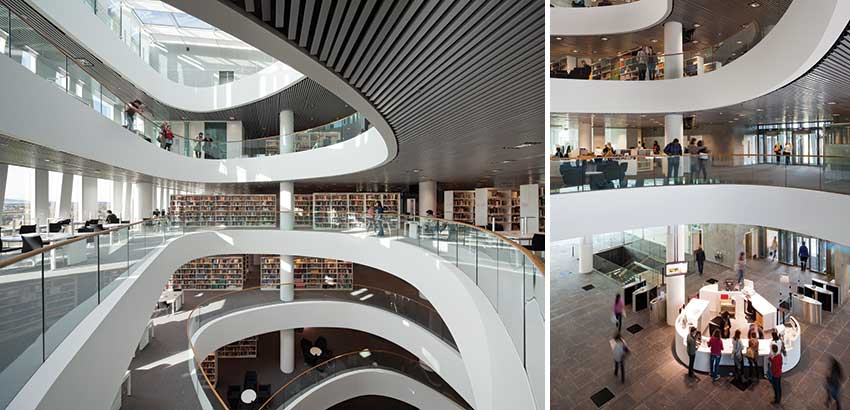
In addition to housing a collection of over one million books, the new library also provides an advanced learning environment by means of a series of flexible spaces offering various opportunities for individual study, group-working, seminars, and meetings.
Established in 1495, the University of Aberdeen is the fifth oldest English-language University in the world. The practice SHL won the Aberdeen competition to design its new library in 2005 beating world's renowned architectural firms. The client wanted a building to be an icon that would make an impact on the skyline and act as a hub for all activities in the surrounding areas. SHL provided a simple logistical solution for the project and proposed that the new library should be built alongside the existing fully operational Queen Mother library, reducing disruption.
Structural Design
While designing the project, SHL was very sensitive to the significance of libraries in contemporary public life. Schmidt believes that contemporary society has lost its 'third space' (a term coined by the American urban sociologist Ray Oldenburg). 'Today, we have places to live and work, but sadly lacking in the third type of spaces.' The University of Aberdeen library is conceived in this spirit, with the ground floor open to the public with lounge and cafe, an exhibition, seminar space and a media wall. It also has 'Break-out' zone on Floor 7, where students can enjoy panoramic views of the city while reading, working on a laptop, or engaging in quiet conversation.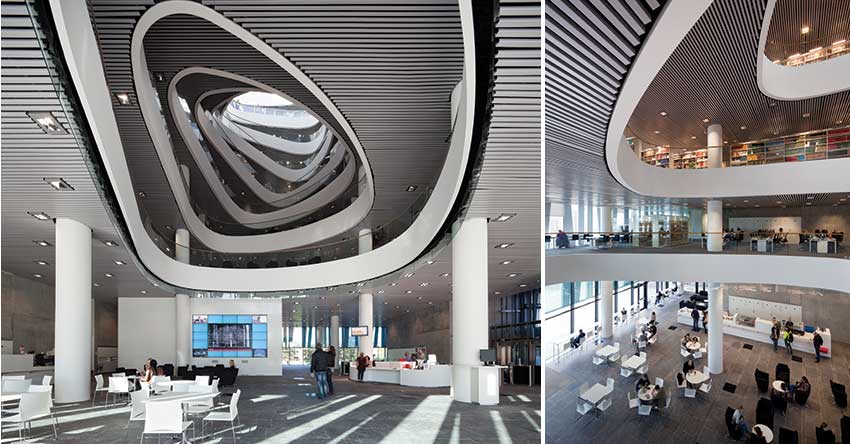
The library is an eight-level building where its atrium's vast spiraling volume connects all eight storeys and with its sweeping contours and organic form, this space contrasts with the clean cut exterior profile. The lifts, stairs and circulation are neatly packed into service cores on north and south of the building. The steel structure is hidden within the skin, creating clear deep floor plates animated by the multi-colored books and only interrupted by the atrium. The building is equipped with all the latest technologies and new learning environments.
Sustainability
Special emphasis has been given while designing and creating a green and sustainable project thus minimizing long-term running costs and energy use. All working environments are generously day-lit. Through the use of high performance glazing, the amount of solar gain and heat loss is kept to a minimum. The ratio of glass to solid panel on the internal elevations is approximately 50% and this irregular pattern of insulated panels and high performance glazing creates the effect of a shimmering façade during the day and a soft glow at night, creating a luminous landmark for Aberdeen.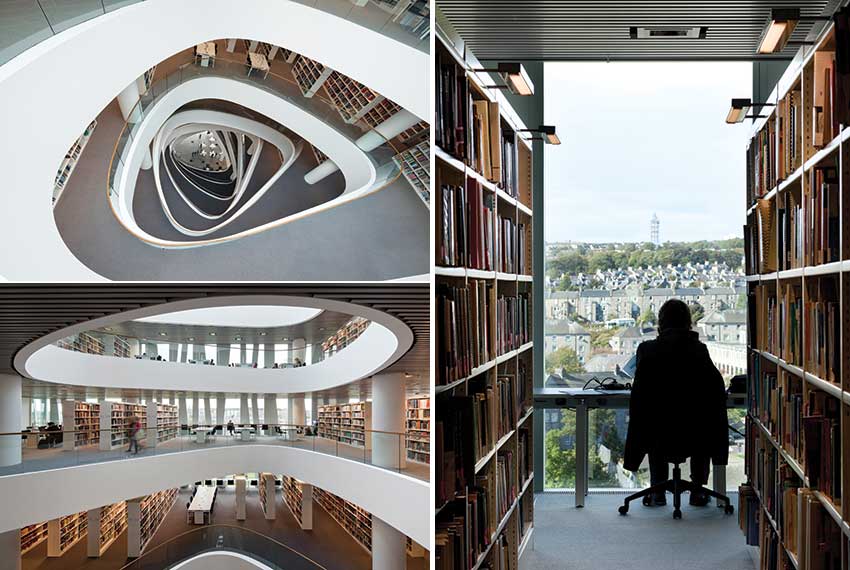
In terms of sustainability, photovoltaic cells are located on the roof to supplement the building's electricity requirements. A water recycling system is utilized to collect and store rainfall from the roof - the rain water is then recycled for use in lavatories.
A green displacement ventilation system has been utilized to save energy and system supplies air at 18-19°C, thereby obviating the need for mechanical cooling for a significant period of the year. System pressure drops are much lower than in conventional fan coil unit systems, and this permits the use of far smaller fans to circulate air through the system. Temperature stratification allows for the conditioning of the occupied zone only, and in this way energy is not wasted in conditioning the unoccupied zone directly beneath the ceiling.
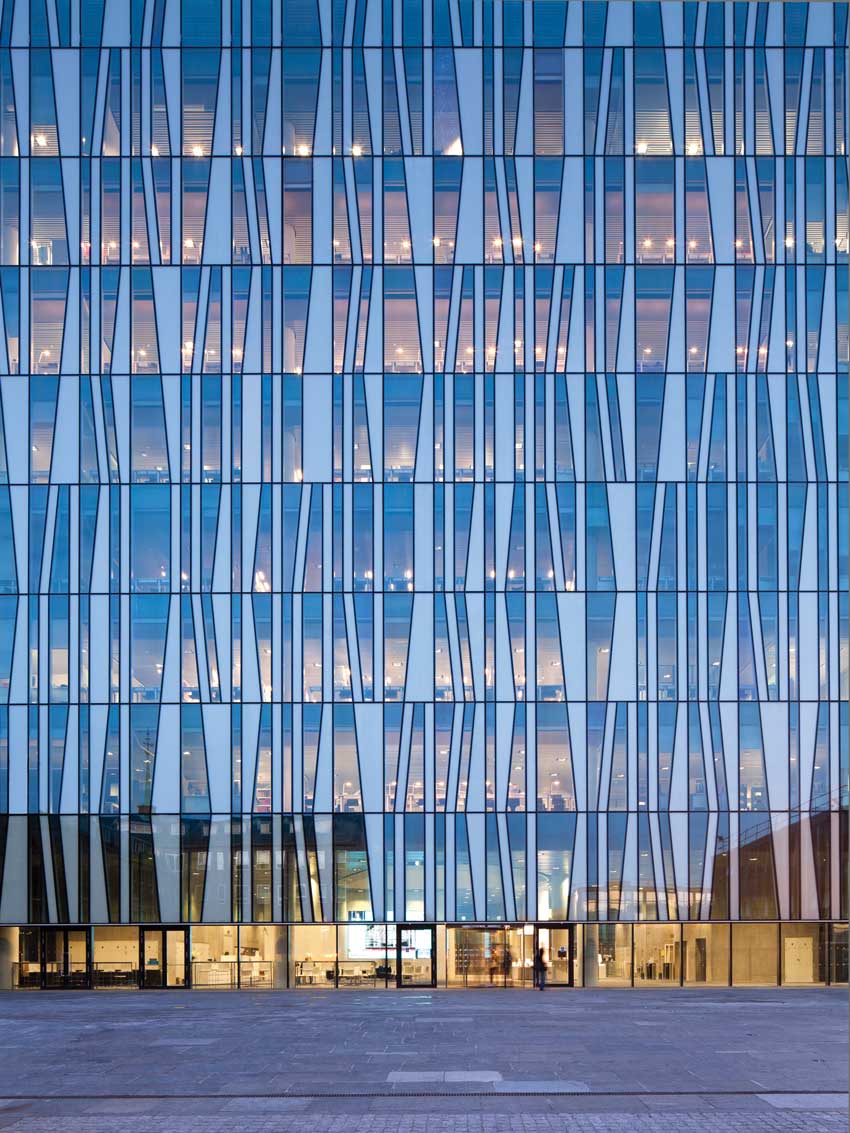
The university's traffic strategy also emphasizes sustainability, encouraging the use of sustainable transport systems such as cycling and buses rather than cars. Facilities such as showers for staff cycling to work have been provided in the new building. As a result of all these, the project has achieved a BREEAM Excellent rating.
The new Library is designed to be both a meeting place and a cultural centre for the University and the wider Aberdeen community. Construction started on this project in September 2009 by main contractor Pihl UK and was completed in 2011. The £57million project is the largest capital fund-raising project yet undertaken by the University, receiving support from alumni and private donors around the world, from companies in many sectors of business, and from charitable trusts local and national.

SOM to Create Green Tech City in Hanoi
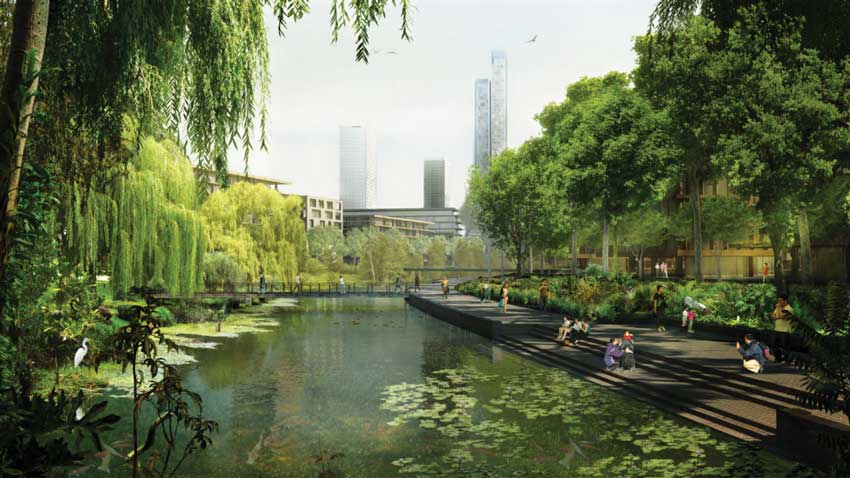
Skidmore, Owings & Merrill, Inc (SOM) has been awarded, by Blenheim Properties, the commission for the master plan for Green Tech City in Hanoi, Vietnam.
SOM's master plan incorporates advanced city design methods and sustainable principles to reduce the demand for non-renewable resources and typical civil infrastructure. Covering an area of 145 hectares, the plan integrates two existing villages with future development and provides necessary community amenities to serve a future urban population in excess of 20,000 people. The Master Plan expands and reinforces the local traditions and green urban character of Hanoi. The plan also engages and enlivens the strategic green landscape corridor envisioned at the city scale along the adjoining river and applies state-of-the-art technology in carbon emissions reduction, energy needs reduction and smart infrastructure.
In addition to a new linear riverfront park, the Master Plan generates a series of organic, low-rise, pedestrian-friendly residential neighborhoods within the planned 'Green Corridor'. This is balanced by a more urban and dense edge of highrise development articulating the future skyline of the district. A complete urban living environment will emerge on site, including a variety of housing types integrated with schools, healthcare clinics, sports and other public facilities. One of the key architectural features at the heart of the plan is a new Cultural Forum building animating a civic piazza, establishing an iconic meeting space for this new community and the wider population of Hanoi. This building is designed to accommodate a range of uses including an auditorium, TV studio, art gallery, mediateque, and cafés.
The fragmented system of existing agricultural water channels on site is reorganized into an interconnected network of landscaped waterways. These will provide continuous bands of public green space defining intimate outdoor spaces for each neighborhood. This water system assists in managing flood control, preventing rainwater runoff into surrounding areas, filtering and cleansing grey water and providing a source for irrigating new viticulture activities. New public spaces also protect and encourage new native wildlife habitats to form. In addition to the new city riverfront park, these spaces include a linear canal park, a lake-front district, public gardens, children's play areas, sports and recreation fields, a wetland centre and nature walks.
The plan was informed by a rigorous process designed to optimize its environmental sustainability. Wind and solar analyses were used to determine the optimal orientation of streets and buildings in order to create comfortable urban micro-climates. These ensure the plan will harness natural environmental conditions in order to maximize comfort and minimize infrastructure requirements as well as operational energy costs. Sustainable district-wide technologies like canal water cooling, tri-generation plants, waste recycling and rainwater harvesting are integral components of the plan. While contemporary building technology is championed, the plan also promotes low-tech passive design strategies for environmental-friendly architecture that is appropriate for the local economy and Vietnamese climate and culture.
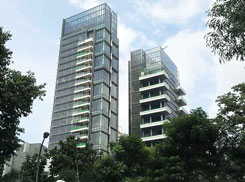
The Marq Singapore
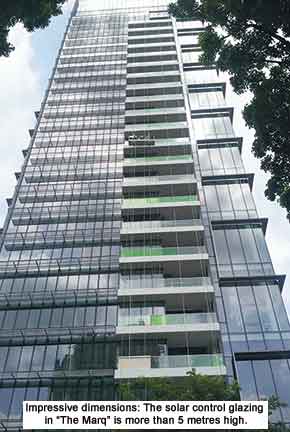
Paterson Hill is known as one of the best addresses in Singapore. Located in the centre of the metropolis, this quarter offers the most exclusive choices in terms of shopping, food, and wellness. Lately, it is also home to "The Marq". The owner company SC Global has been targeting the local and international super-rich and the has been very successful: the largest and most exclusive apartments were sold within a matter of a few hours at exclusive prices. The two towers of The Marq are named "Signature Tower" and "Premier Tower". There are 66 exclusive apartments on a foundation of 11,500 square metres. The Premier Tower houses 42 four-room apartments of 280 square metres each. In addition, there are three penthouses with 1,020 square metres each. The Signature Tower has 21 six-room apartments (560 square metres) with so-called "Infinity Pools" attached to the facade – special pools with a concealed water edge – that are especially striking on the facade of a skyscraper.
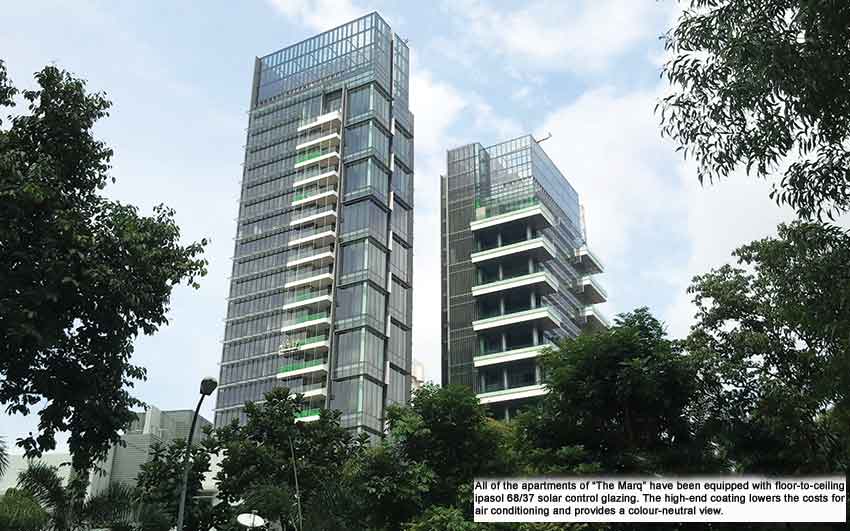
Solar Control Glazing
All of the apartments are impressive due to their up to 5.50 metre high floor-to-ceiling glazing over the entire width, which further enhances the view over the breathtaking skyline. The colour-neutral glazing lets the residents enjoy the pure colours. The high-end coating ipasol neutral 68/37 by Interpane also keeps the rooms from overheating. This lowers the costs for air conditioning. Especially in the tropical climate of Singapore, located almost at the equator, this is an important factor. The intensity of the solar radiation is correspondingly high, even in a prevalent rainy and humid climate. The glazing's solar factor of 37% as per EN 410 is low. Nonetheless, an enormous amount of daylight enters the rooms (tV = 63, or 65%, depending on the glazing design). It is in this way that the energetic properties of the glazing lower the operating costs and preserve natural resources.
This glazing features another specialty: Interpane equipped the surface of the inside pane, which faces the gap between the two panes (position 3) with an additional iplus E thermal insulation coating. In this case, it is not so much for keeping the building from cooling down too much, but rather for lowering the inside reflection from eleven to eight percent. This enhances the view outside, especially at night when the lights are on. The outside reflection was also lowered from ten to eight per cent, which results in a very colour-neutral appearance and maximum transparency. Due to the vast size of the panes alone, the design of the glass facade is massive: on the outside, 8 mm heat-strengthened glass with ipasol neutral 68/37, a gap between the inner and outer pane, silicone sealing, and on the inside 8 mm heat-strengthened glass with iplus E. For the largest panes: on the outside, 10 mm heat-strengthened glass with ipasol neutral 68/37, a gap between the inner and outer pane, silicone seal, and on the inside 10 mm heat-strengthened glass with iplus E.
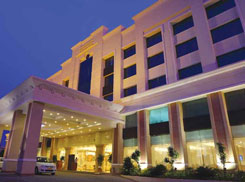
Accord Hotel Puducherry

Puducherry is an ideal travel destination and the Accord Puducherry is the symbol of a luxurious sojourn in a city filled with a nostalgic past and an exciting future. This hotel is an elegant oasis of space and calm offering spectacular views of the city from all around the complex. It is conveniently located in the heart of Puducherry's vibrant business and entertainment area and close to the Auroville Ashram complex. It is adjacent to the Rajiv Gandhi Statue that welcomes any traveler to the city.

The architectural style is neo-classical reflecting the colonial style prevalent in Puducherry. The elevation is elegant and has mixture of Indian Dholpur stone, toughened glass, textured paint and wood. The simplicity of horizontal and vertical lines works in perfect harmony with the proportions of the building. The plan of the complex is U shaped and looks inward to the swimming pool.
The sweeping Indian dressed granite driveway porte-cochere is large and inviting and is reminiscent of the French colonial architecture. The wide glass doors opens into a breathtaking double height lobby that is entirely marble clad, topped by a huge golden oval gold leaved ceiling. The giant gold oval ceiling has three magnificent cut glass chandeliers that emphasize the magnificence of the space.
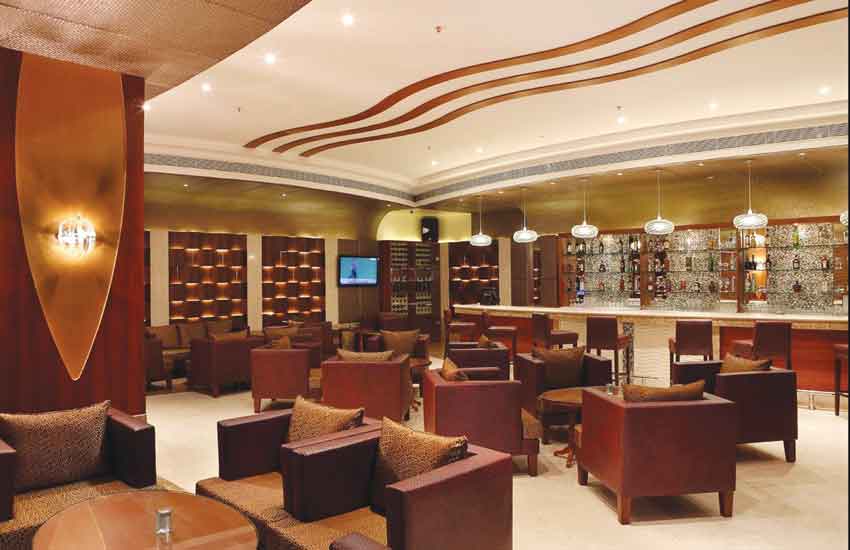
The Italian marble flooring is an exercise of Florentine marble design that is positioned geometrically opposite to the oval ceiling. The symphony of varying shades of Italian marble as well as geometric motifs is a testimony of finesse in design and execution. The far end of the lobby culminates in a marble reception desk that has a wide curve terminating with two large marble globes. Behind this desk are three marble alcoves framed by massive marble columns. Each marble alcove is in turn framed by three delicate lace of marble lattice work made entirely of the purest white Indian Macrana marble. The artwork is a unique design of marble and metal work that is abstract in nature.
The Eastern wall of the lobby is clad by large mirrors with specially commissioned artwork that forms the center piece of the composition. The lift wall has intricate marble work crowning the elevator openings. The lobby opens out to the coffee shop and bar on right side and the pre-function areas to the banquet hall on the left side. The pre-function area is defined by a long row of magnificent tall marble columns reminiscent of renaissance palaces. The marble motifs are set in modular fashion breaking the spatial scale into areas of pleasant sequential experiences.
The banquet hall "Crystal" in the ground floor has large carved doors with curvilinear handles ushering the visitor to a truly royal interior filled with plush carpets of ceremonial Indian colors of red, yellow and green. The design motifs in the ceiling are reflected in the carpet design. The elevation of the walls have marble columns, fabric paneling, and carved light boxes – alternating with one another to give a true feast for the eyes. All intricate power and communication arrangements of the latest design have been installed to give the end-user a smooth and comfortable conferencing experience.
The lobby opens out into the glazed areas of the coffee shop by way of a carved wooden portal. The coffee shop "Seasons" provides yet another facet of an excellent aesthetic and culinary experience. The garden forms the design concept of the coffee shop and the regal gazebo reflects this theme aptly. Contemporary designs in terms of the Italian marble design and wall cladding is cleverly inter-twined with Indian carved panels made of Indian white Macrana marble. The cove ceiling has three modules in the dining area and one in the food display area. Ornate cut-glass chandeliers complete a regal yet landscape oriented coffee shop. The furniture adds to the informal yet regal culinary experience. The colour scheme is in muted shades of beige and white with flashes of green.

The bar aptly named 'The Zodiac' evokes a cosmic feel by the wave like curvilinear design of the flooring, ceiling, elevations and bar counter. The orbs of lights above the bar counter throws lights in an aesthetically pleasant fashion completing the cosmic experience. Shades of Botoccino and Brown Emprado marble harmoniously blend into one another and also forms part of the huge curved bar counter. The bar display is resplendent with mother of pearl panels that glow in the soft pendant lighting of the bar ceiling. The wood panels are also wave shaped with clever lighting and emphasized by slim vertical tiny metal rods that give visual anchorage. The huge curved leather panels form the primary peripheral elements of the ceiling design culminating in curved wooden members in the center.
For the convenience of the business traveller in Puducherry, the hotel also has a full-service Business Centre, open 24 hours daily. Giving a corporate feel, the extensive wood veneer paneling coupled with patterned blue carpeting, this business center has all hi-tech facilities for any guest.
The bar overlooks the pool area which has Italian Bizazza tiles in blue and white patterns complete with wooden pergolas and Italian marble columns. A Bizazza tile marine themed mural overlooks the pool area.
The guest corridor is laid with marble skirting and borders encircles a rich carpet corridor gives the visitor a welcoming feel to the guest room. The guest room is designed along modern lines with furniture of light veneers, contemporary light fittings, and artwork. Indirect lighting is a feature of the guest room. The bathroom and toilet fittings are all German and the entire bath/ toilet areas are clad with rich Italian marble. The suite rooms are designed along contemporary lines and have all the modern wi-fi amenties.
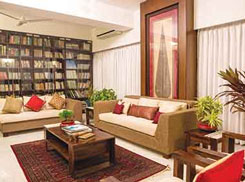
Raghavan Complex, Chennai

Nestled on the bustling TTK road in Chennai, is a stately elegant building that is a beautiful blend of contemporary Zen and organic architecture. The concept was an urban edifice designed with traditional elements such as a courtyard and contemporary green design. Each element was designed using natural materials and there is a clear integration of the outdoor space of the courtyard with each indoor architectural space. The clients are firm believers of nature and vastu and the design brief emphasised the need for integrating nature with every part of the living spaces.

Contemporary Architectural Design
The Raghavan building is a mixed use building that has a swanky I-Phone store on the ground floor and first floor level. The building also has residential apartments in the second and the third floor. The second floor houses the grandparents and grandchildren apartment and the third floor houses the sons and daughters' apartments.
Natural stone is an integral part of green design and the building is an example of how the ancient traditional materials can be used in any part of the exterior and interior of the house. The compound wall, exterior paving, indoor flooring, counters and elevation of the building is extensively clad by its 4 inches thick Sadarhalli grey granite especially hand-picked and transported from the Sadarhalli quarries of Karnataka.
Taking on the principle of Zen and the stone temple of karnak in Egypt, each stone member of the elevation is 15 feet high 4" thick granite monolithic blocks. This monolithic granite blocks are combined with natural wood fascia, steel and glass to form an elegant symphony of contemporary architectural design.
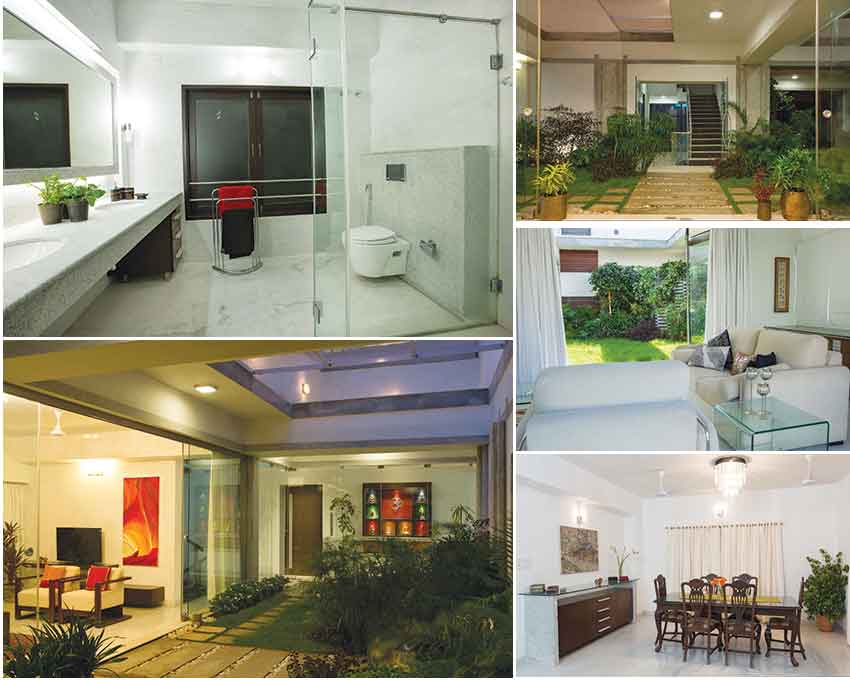
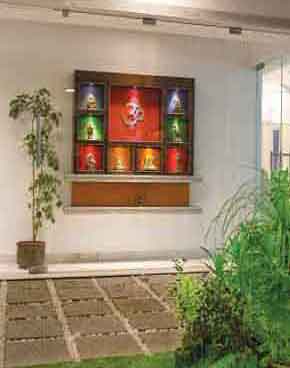
The entire building, both interiors and exteriors, is built of Indian granite and marble as well all furniture and furnishing sourced entirely from India. The interior furnishings and furniture are contemporary in nature, almost ascetic in style. The design is both low maintenance, cost effective and energy efficient.
The concept of the landscape is simplicity, tranquillity and grace and this effect is emphasized by the usage of grey granite, pebbles, wild grass and elegant shrubbery. The stone sculpture is designed along Zen principles also integrates a waterfall. The combined effect is one of a peaceful forest in an urban jungle
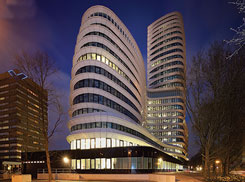
A Greener Approach to Tall Buildings

PARKROYAL on Pickering, Singapore
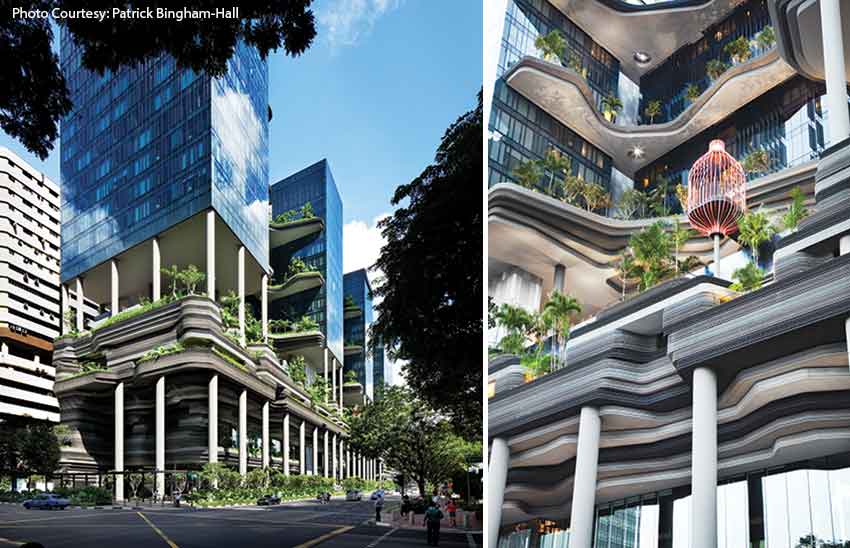
Designed as a hotel and office in a garden, the project, PARKROYAL on Pickering, at Upper Pickering Street is a study of how to increase the green replacement in a highrise development in the city center and multiply it in a manner that is architecturally striking, integrated and sustainable.
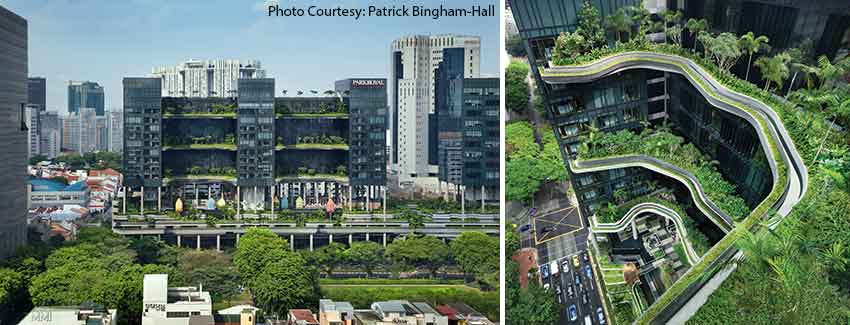
Located in central Singapore, the site is at a junction between the CBD and the colorful districts of Chinatown and Clark Quay, and faces Hong Lim Park. A contoured podium responds to the street scale, drawing inspiration from a combination of landscaped bonsai arrangements that are modelled, chiselled and spliced to mimic natural landscapes and mountain rock formations as well as that of the contoured paddy fields of Asia. These contours are precast concrete elements of modular radii, allowing the complex, sculptural podium to be put together from a basic 'kit of parts'.
| At a Glance: | |
| Project | : PARKROYAL on Pickering, Singapore |
| Location | : 3 Upper Pickering Street, Singapore 058289 |
| Design Inception | : Dec 2007 |
| Start of Construction | : Dec 2009 |
| Opening | : January 2013 |
| Project Cost (construction) | : S$ 137 million |
| Gross Floor Area | : 29,811.54 sqm |
| Plot Area | : 6,958.9 sqm |
| Architects & Interior Design | : WOHA |
| Client | : UOL Group Limited |
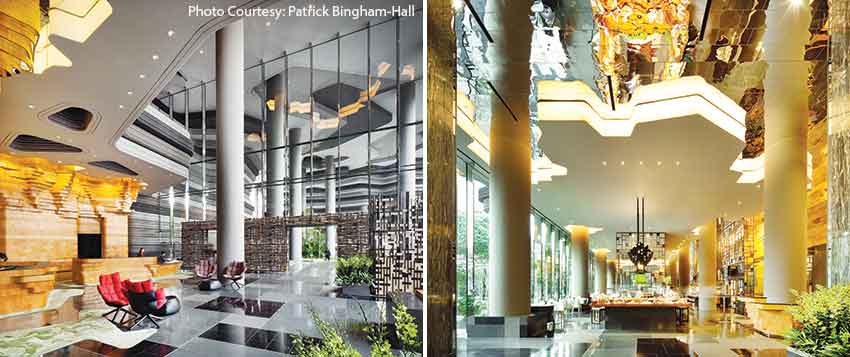
On the ground the contours create dramatic outdoor plazas and gardens which flow seamlessly into the interiors. Greenery from the park is drawn up in the form of planted valleys, gullies and waterfalls. The landscaping also conceals openings to the above ground carparking while allowing in air and natural light. The top of the podium is a lush landscaped terrace housing the development's recreational facilities, with infinity edge pools opening up unobstructed views of the city. Birdcage cabanas perched over the waters add interest and delight.
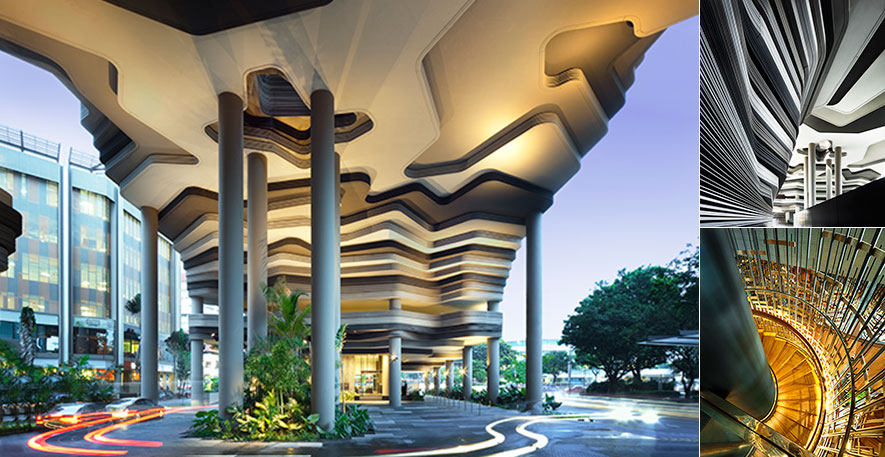
The crisp and streamlined tower blocks harmonize with surrounding high-rise office buildings. They are attenuated into an open-sided courtyard configuration, breaking down the 'wall of buildings' effect and maximizing views and daylighting into the building. Blue and green glass creates a patina that recall the waters of Singapore River adjacent. Lofty 4 storey sky gardens bring lush greenery directly to the rooms and break down the scale of the building. Corridors, lobbies and common washrooms are designed as garden spaces with stepping stones, planting and water features which create an alluring resort ambience with natural light and fresh air, instead of being 24-hour energy guzzling air conditioned spaces. Tall overhangs work together with leafy foliage to screen these spaces from the weather and direct sun.
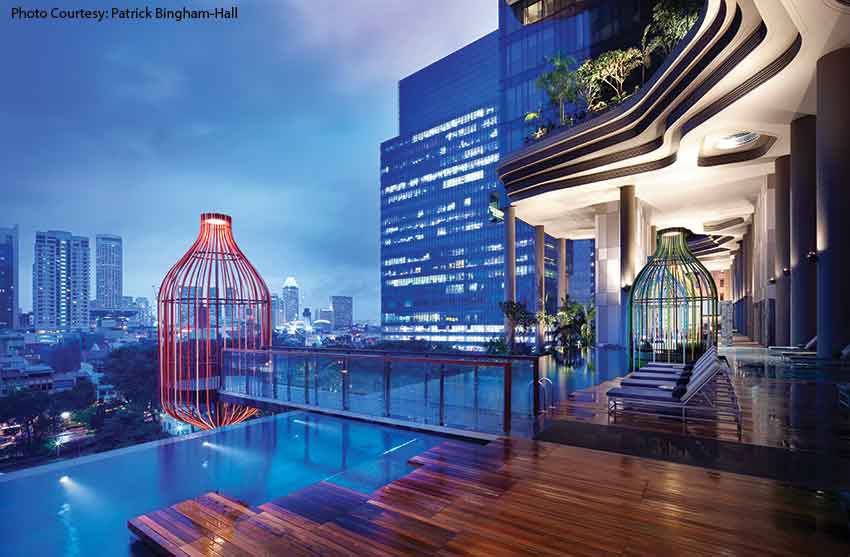
A total of 15,000m2 of skygardens, reflecting pools, waterfalls, planter terraces and green walls were designed; this is double the site area or equivalent to the footprint of Hong Lim Park! A diverse variety of species ranging from shade trees, tall palms, flowering plants, leafy shrubs and overhanging creepers come together to create a lush tropical setting that is attractive not only to the people but also to insects and birds, extending the green areas from Hong Lim Park and encouraging bio-diversity in the city.
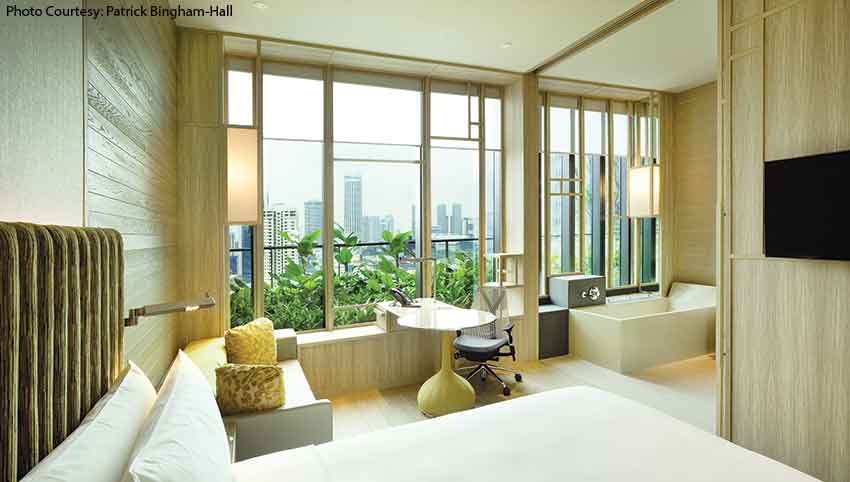
These landscapes are designed to be self-sustaining and rely minimally on precious resources. Rainwater collected from upper floors irrigates planters on the lower floors by gravity supplemented by non-potable recycled Newater, which will also be used for all water features. Photovoltaic cell arrays on the roof will power grow lamps and softscape lighting, making these Singapore's and perhaps the world's first Zero Energy Skygardens!

This project is awarded Singapore's Green Mark Platinum, the nation's highest environmental certification. The hotel officially opened in January 2013.
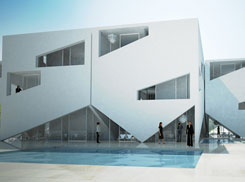
New Danish Embassy, New Delhi

Designed by 3XN, the new Chancellary for the Danish Embassy in New Delhi demonstrates the story of the classic Danish house turned upside down. The typical Danish house has four outer walls to protect against the cold and wind and the saddle roof keeps the snow and rain at bay. In India, on the contrary, the hot climate creates the need for protection against the sun and cool, shaded rooms.

The Chancellary is constructed around 12 simple inverted houses combined in a repetitive structure. The easily recognizable Danish shape is turned on its head enabling one to walk in the shaded galleries along the roof of the inverted houses. Water basins cool down the adjacent areas and create beautiful reflections on the ceilings of the buildings.
| Project at a Glance | |
| Project | : Danish Embassy |
| Location | : New Delhi |
| Architect | : 3XN |
| Developer | : Danish Foreign Ministry |
| Status | : Designed |

The compound includes a number of different functions in each three-level house. The spine of the structure is formed by the triple high hall and reception area leading to two different chanceries – the Danish on the right and another country on the right. The incubator rooms function as temporary offices for Danish companies expanding into India. Three residence houses are placed at the back – away from the entrance activities – placed around their own swimming pool and garden area with space for play and recreation. The buildings also contain parking and showroom in the basement, roof terraces, and visa offices with their own separate entrance. The decentralized structure with small volumes makes it possible for the Chancellary's many different activities to unfold without necessarily interfering with each other.
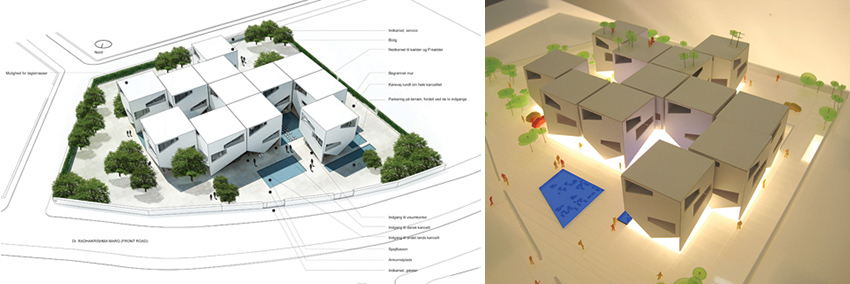
Four basins connect the two chancellaries, the residences and the reception area like blue courtyards. They are carefully decorated with art, stepping stones and water lilies for soothing visual breaks for the employees and guests. A mix of Danish and Indian trees provides outdoor shading areas in the garden and the surrounding wall with climbing plants is a colorful backdrop to the scenery.
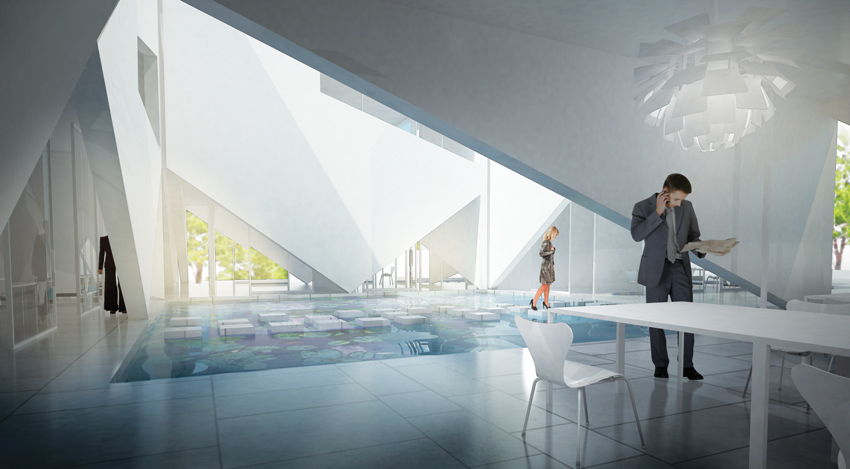
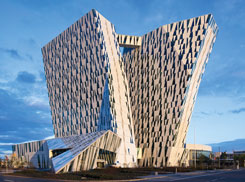
Bella Sky Hotel - A New Landmark in Copenhagen Skyline
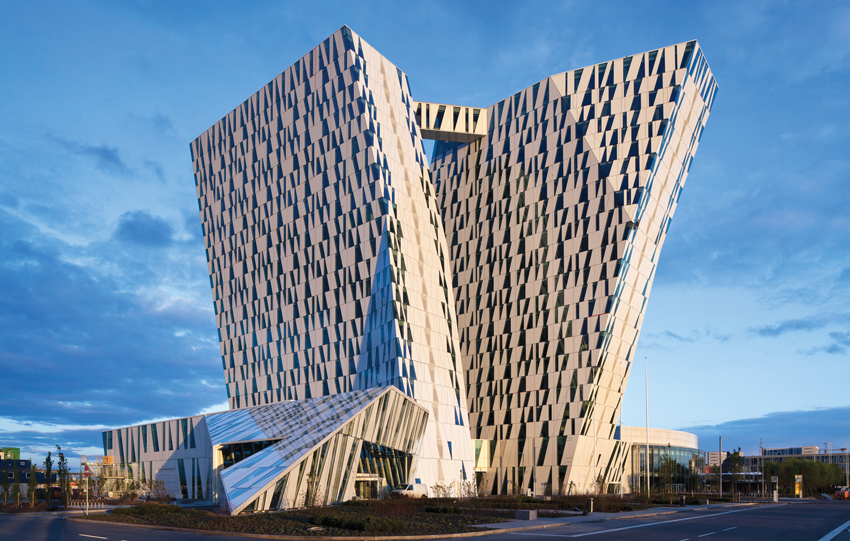
Scandinavia has recently opened its largest hotel that symbolizes not only the identity of the modern Ørestad area of Copenhagen but also marks the Capital's increasing importance on the international convention and congress scene. The sculptural profile and visibility of the hotel from the various corners of Copenhagen make it an architectural landmark which will draw many visitors to the Ørestad neighbourhood.
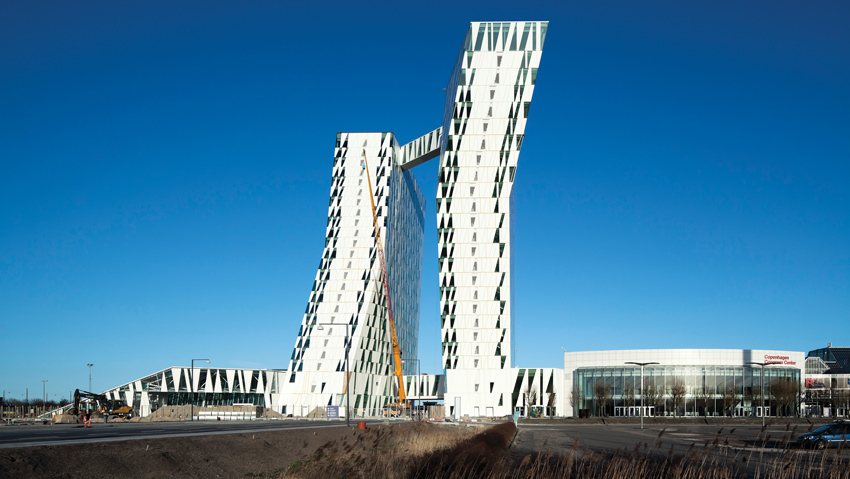
With its 814 rooms and 30 conference rooms, the Comwell Bella Sky Hotel offers a wealth of new accommodation and resources for the Bella Convention and Congress Center in Copenhagen. In future, this will draw an even larger segment of the international world class conferences and events to Copenhagen. Designed by 3XN, Bella Sky Hotel is a distinct new profile in the Copenhagen skyline with the two towers reaching up 76.5 meters, and leaning out at a staggering 15 degrees in each direction (11 degrees more than the leaning tower of Pisa). This results in a sculptural building unique in Copenhagen which has started drawing many curious looks from all over the city.
| Bella Sky Facts | |
| Architect | : 3XN Architects, Denmark |
| Location | : Bella Center, Center Boulevard S, Copenhagen S, Denmark |
| Client | : Bella Center A/S |
| Size | : 42.000 m2 |
| Height | : 76,5 m (23 floors) |
| Number of Rooms | : 814 rooms and 30 conference rooms |
| Engineer | : Rambøll Denmark |

'Some of the best views can be found in Ørestad, and therefore it was important to find an architectural solution which allows views from nearly every room. The effect of the leaning towers has also resulted in corner rooms where the building angles create a view which is actually underneath the room! It gives the illusion of floating above the view itself,' says Kim Herforth Nielsen, Principal and Founder of 3XN. 'Of course, the most fantastic view of all is from the Hotel's Skybar which is open to the public' he added.
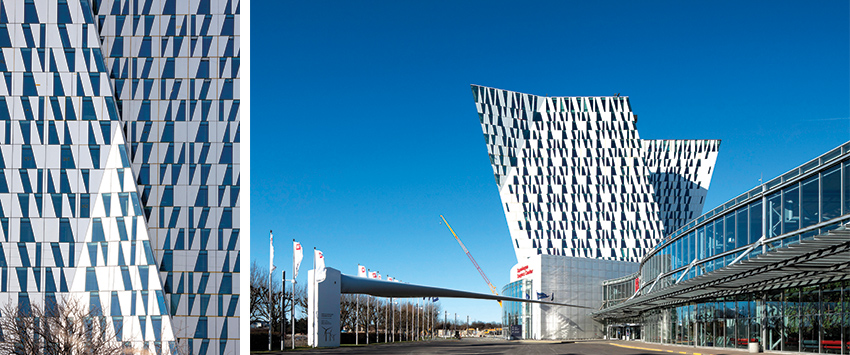
'We have knowingly worked towards designing a building unlike anything else in Copenhagen - And we did that because Ørestad, which is a new city neighbourhood is also unlike any other place in Copenhagen. Bella Sky is designed specifically to reflect the identity of Ørestad, contributing in a positive manner,' he said.
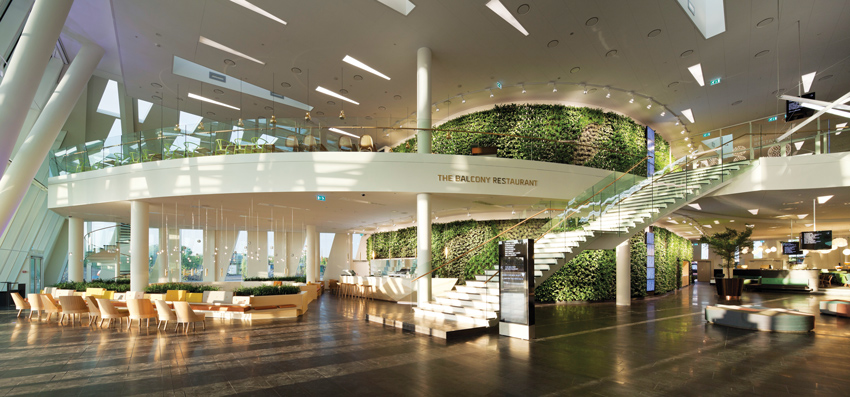
Stylish Interior Strategy:
The Best from Nordic traditions3XN has also designed a large portion of the interior, and in that regard has aimed to differentiate itself from other hotels.
Mr. Nielsen goes on saying, 'although Bella Sky is the Nordic region's largest hotel, we have done everything to ensure that the hotel doesn't give the typical impersonal and formal feeling that so often defines large hotels. Therefore, we decided to interpret the overall theme as New Nordic Cool. We looked at how Scandinavians approach the design of their homes, how they live – and then chose the best of our design tradition for the Bella Sky Hotel. Key words for us were simplicity, functionality and high quality, both in design and materials.
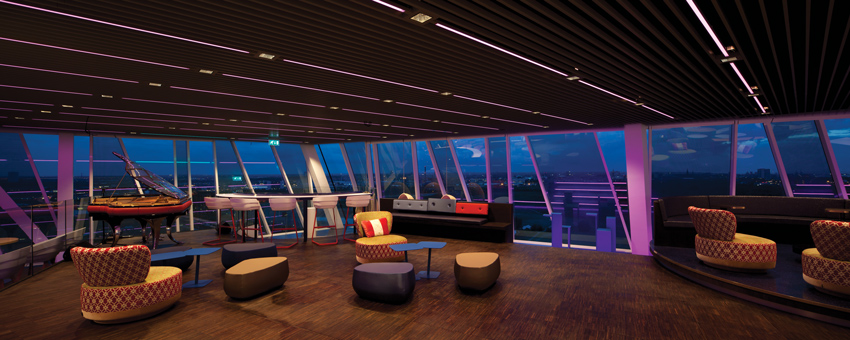
Therefore, anything synthetic was banned in the selection of materials for the hotel's 814 rooms. Carpets are in wool, bed sheets in high thread count cottons, and there is a prevailing use of natural materials such as smoked oak and leather found throughout the décor. The smokey color palette gives the rooms warmth and at the same time creates references to the Nordic nature, which is evident from the hotel views over the nature park, 'Amager Common.'
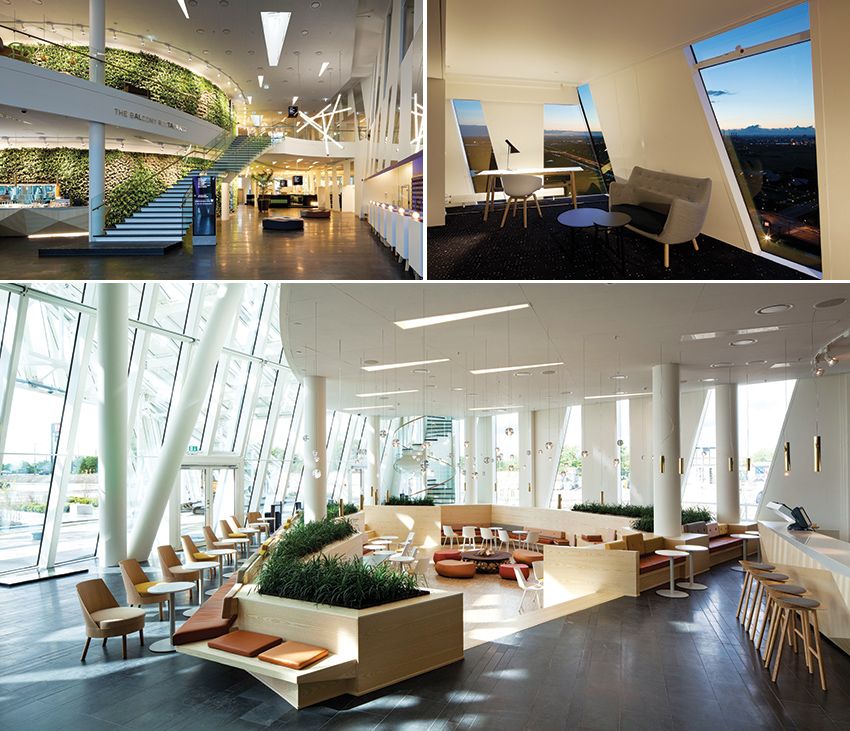
3XN has chosen the best from the Nordic tradition in terms of furniture designers, and has used a strategy comprising both new and classic design from a selection such as Hay, Arne Jacobsen and Finn Juhl. The common thread running through the chosen furniture, textiles and lamps, are round organic forms, which underline the informal and relaxed mood.
The Bella Chandelier - A light sculpture Unique in design and technology
In the Hotel's lobby, guests are welcomed by a specially commissioned light sculpture from 3XN's research and development department, GXN. The Bella Chandelier contains over 7000 LED lamps, reflecting a changing program of cool and warm colours which are reminiscent of Nordic light. The warm reception area is framed by a golden wooden wall, textured to give the impression of a bundle of logs. Compact and mobile reception desks ensure a more personal service, where the hotel's employees can welcome guests in an informal and relaxed manner.Kim Herforth Nielsen describes it further, 'we wish to give the Hotel's guests an experience of walking into a warm, relaxed and friendly space when they arrive at the Bella Sky Hotel. The décor and the interior strategy aim to complement the personal service level, thus giving the guest an informal feeling of freedom from the very first impression.

With the aim of bringing art and science together in one unique light and color experience, the multidisciplinary team of GXN was on a journey exploring the realm between structure, technology and design. And finally they commissioned specially designed light sculpture 'The Bella Chandelier' which is inspired by the stringent yet dynamic design of the Bella Sky.
In several areas, the Bella Chandelier is an example of pioneer work in creating light installations: Hence, the custom milled aluminum cores used as compression rods are merely 36 mm in diameter, making them the slimmest of their kind. Furthermore, the light and spacious expression of the Bella Chandelier is a result of its tensegrity structure where a perfect equilibrium of forces is reached through a precise balance of the elements. Never before has a tensegrity structure of this size been made with as high level of integrated and optimized design.
This extremely slim construction together with the integrated dynamic lighting makes the Bella Chandelier stand out worldwide as an extraordinary example of engineered art. At the same time, the light sculpture perfectly reflects the architecture and design of the Bella Sky.
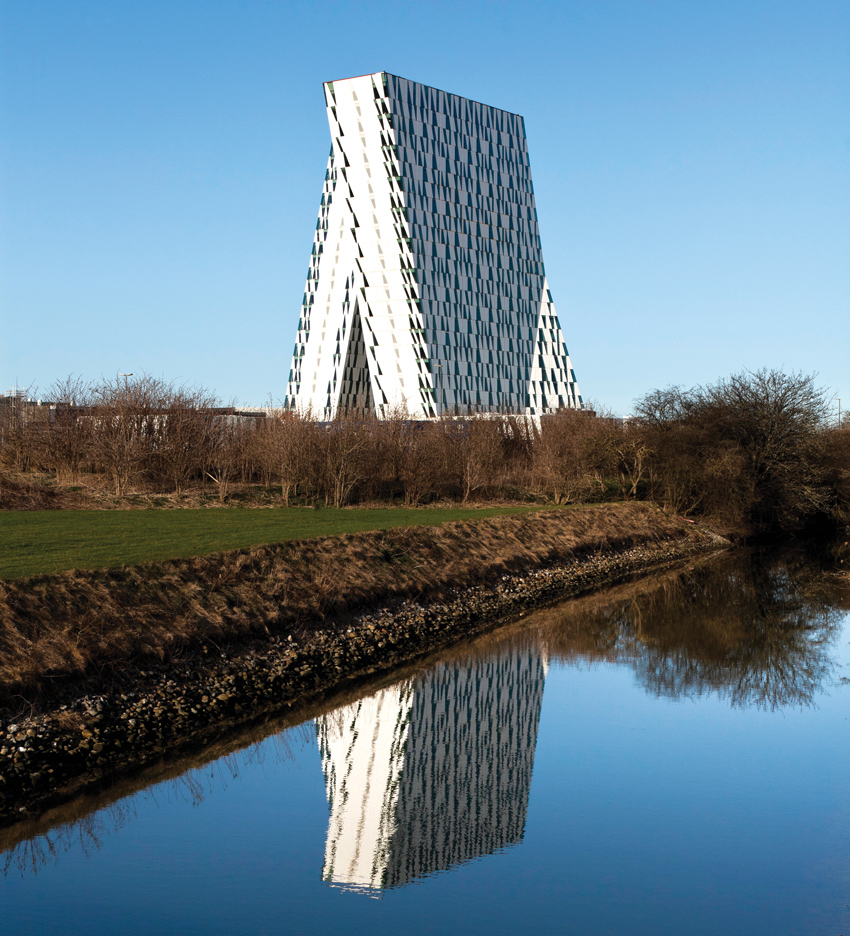
The Director of Bella Center, Mr. Arne Bang Mikkelsen is delighted that the newest addition to the Bella Congress and Convention Center is more than just the sum of its parts. He says, 'We have received an architectural icon, a symbol for Bella Center and for Copenhagen, which through its unique form provides people with an experience both from the outside as they approach the hotel and on the inside as they experience the many facilities and amenities offered. The Hotel is so sculptural, that we have decided not to add any signage on the exterior. The architecture speaks for itself.' At the same time, the Director, Arne Bang Mikkelsen mentions that the collaboration with 3XN architects was 'perfect.'
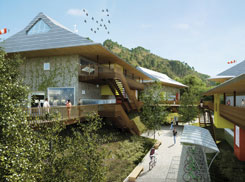
Eco Campus IIT–Mandi, H.P
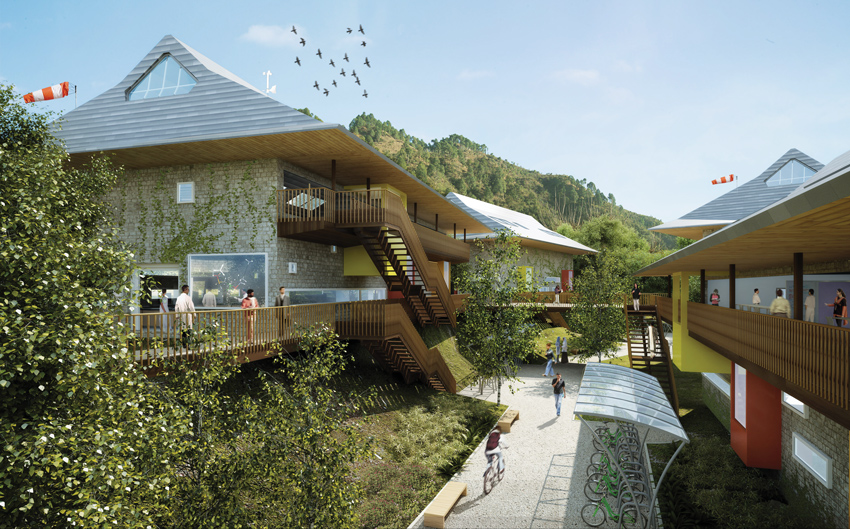
Following an international competition, BDP's Indian studio was appointed by the Indian Institute of Technology (IIT) to prepare a masterplan and detailed design proposals for a new 230 ha learning Eco-campus on the outskirts of Mandi, H.P. BDP's design for Ecocampus which can assist the institution to move towards environmental sustainability through good operational and management practice, won the competition.
The human scale sustainable campus is on a site with great natural serenity and beauty. Its layout responds to the microclimate and topography of the steep site in the part forested hills in the western Himalayan region.
As per the proposal and design, the project would be completed in a phased manner where Phase I includes shared state-of-the-art laboratories and workshops in learning houses situated on various levels and connected via pedestrian bridges. A market square forms the heart of the campus and creates a place to encourage social interaction and celebration.
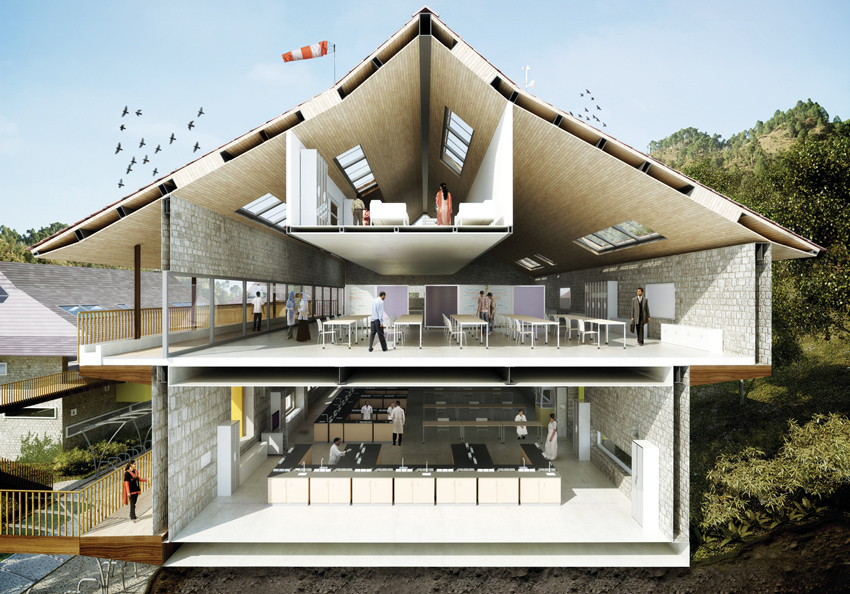
The faculty staff housing element forms a retreat on the higher levels at the campus peninsula. It is laid out in a village setting offering fantastic views. Proposed building typologies echo the traditional style of Himalayan vernacular and strive toward a new architecture for the region.
| Project at a Glance | |
| Project name | : IIT Mandi - Eco–Campus |
| Location | : Himachal Pradesh, India |
| Program | : Educational complex |
| Area | : Site area: 230 ha |
| Year: Design | : 2011 (international competition, 1st prize) |
| Phased completion | : 2012-2015 |
| Client | : Indian Institutes of Technology |
| Architect, Masterplanner and Landscape Architect | : BDP |
This project will be led by BDP's New Delhi studio with support from the UK headquarters. Phase I could start on site early next year, with phased completion between 2012 and 2015.

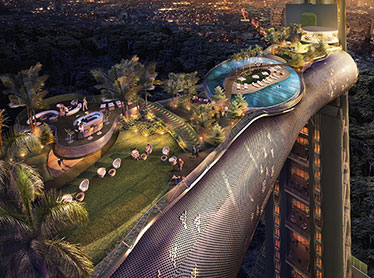
Deya - A Floating Garden in Kolkata’s Skyline

The Indian real estate sector is booming with some great works of architecture such as Cybertecture, Spire Edge, Park Hyatt, SymHomes Mk1, North Eye, World One etc. In the forthcoming wave of contemporary architecture is a great specimen called 'Deya,' which is a part of the project christened 'Atmosphere,' being recently announced by the Kolkata-based developer Forum Group.
Atmosphere will be a new architectural icon – a sculpture in the sky. The Rs.550 crore luxury residential condominium project will consist of two towers of 39-storey each and will be highest in Kolkata. The towers will have a total area of 400,000 square feet and will feature villas in the sky with garden on each duplex unit.
The most picturesque feature of the Atmosphere is the amorphous shape-shifting, tubular piece of floating sculpture called "Deya, (means cloud in Bengali) which is hanging between the twin towers at a height of 500 feet.
Designed by the Singapore based Arc Studio, the magnificent hanging sculpture is intended to look like as if a cloud was gently floating between the peaks of the two towers. The structure will span more than 320 feet in width, 55,000 square feet of usable space and will have a silver lining featuring 15,000 kinetic discs on its surface to keep it glowing.
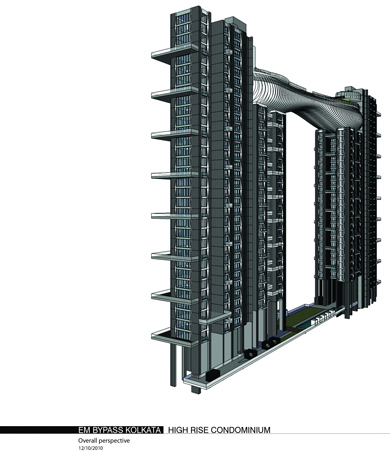
Sitting 100 metres in the air, "Deya" will have a clear span of 65 metres. With four levels, the highest being the party deck, it will serve as a community space, and both its interior and "outer" skin will be put to use. It will command a 360-degree view of the wetlands stretching before it and feature multiple swimming pools, a gym, a spa, squash courts and a badminton court, a jogging track, a mini cinema theater, open-air party deck, an amphitheater, and multiple lounges and spaces for smaller gatherings. And all that is meant for the exclusive use of the 80 families that will reside in the Atmosphere.
Built around a pathway shaped like a Mobius strip (loop of infinity), Deya will change Kolkata's skyline. The developers feel that other than being an object de art for the city, Deya will also be one of the most expensive clubs that the country would have ever built.
The luxury design of this artistic residential sculpture also conforms to the green architectural standards. The Forum Group has provided for the rainwater to be harvested in collection tanks within the foundations of Deya, which will further be used for landscaping and other purposes. At first glance, the property looks like one of the fascinating towers from Dubai, but this skyscraper will be one of the prominent pieces of architecture in the Indian real estate landscape.
The impact of earthquakes and wind at that height has been tested, and a mock-up is being done in Singapore, where for six months the structure will weather the elements.
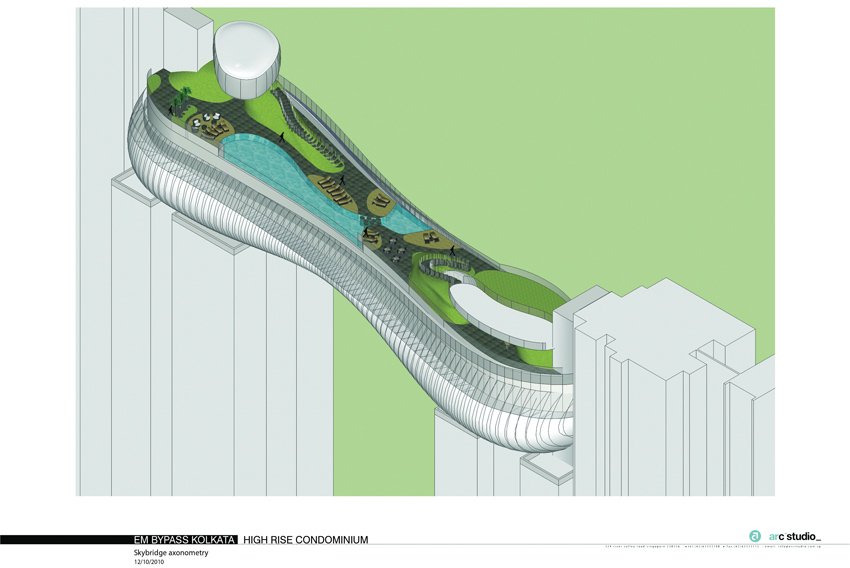
Structural Design
For this unique project, International engineering consultancy Web Structures has been contracted by developer to create a dramatic cloud-like sky-bridge in the Indian city. The earthquake engineering specialists Web Structures brings its expertise of working on tall buildings around the globe to Deya.Part of the design process has been the creation of a mock-up in China. The 1/20th scale model has been used to help in the assembly and scaling of spaces. Dr Hossein Rezai, Web Structures group director, said: "We have come up with a complex structural engineering solution to frame the space the architects have defined. "It comprises more than 1,500 steel sections with a total weight of 1,500 tons, which will be assembled 100 metres above the ground.
"The structure has to straddle between two towers in a combination of a "beam-like" and a "catenary" system. The primary challenges facing the structural system include fundamental issues of safety and serviceability, as well as the critical issue of constructing such a large structure some 40-floors up. Limiting and controlling the movements of the towers at the roof levels where the cloud structure is supported, whilst maintaining serviceability of the towers and the sky-bridge under seismic loads and the high wind forces that prevail in Kolkata have been our primary structural considerations."
Kolkata is in a Level 3 seismic zone, making it vulnerable to earthquake damage. It is also exposed to high wind speeds during monsoon storms. Dr Rezai said: "These conditions present a challenge in themselves. However, when supporting the bridge spanning 65m between them, the ability of the towers to deal with the force and movements caused by these elements becomes even more important.
"As the towers can move independently from one another those movements must also be controlled so the sky-bridge can be safely supported. The supports have been designed to accommodate the movements.
"The movements on top of the roof supporting the structure have been reduced to less than 120mm. The structural arrangement also creates a building that moves laterally when it is subjected to external forces, minimising any potential rotation.The structural anatomy of the final design includes nine different components, each performing a distinctive task to ensure the "whole" structure responds to all the structural requirements in a holistic and appropriate manner."
Longitudinal trusses will span the towers and form the main spine supporting the structure. Horizontal arches will control lateral movements.
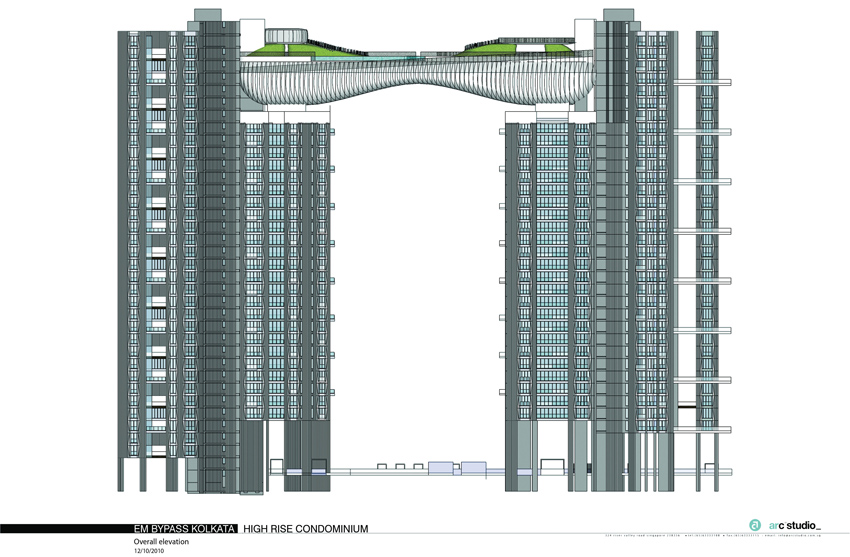
Dr Rezai added: "A sliding/multi-rotational bearing assembly system will create the seismic isolation required for the building. It will allow lateral movements arising from wind loads and seismic effects and will allow the buildings below and the bridge above to move relative to one another in an independent manner.
Web Structures, with offices in Singapore, Kuala Lumpur, London and Shanghai, has overseen the creation of a sky-bridge linking three towers at the 50-storey Troika development in Kuala Lumpur, designed by Norman Foster.
Other than the structural design which is created by Web Structures, the wind tunnel investigations has been done by Tony Rofail of Australia-based Windtech Consultants. The contractor is Mero Construction, which has a subsidiary in Chennai. The lighting is being conceived by the Japan-based Kaoru Mende, and at night Deya will be lit up by myriad LED lamps. The estimated cost of Deya alone is INR 100 crores. The construction on the project is started by mid March 2011 and will take approximately 30 months to complete.
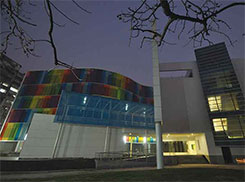
IMI, Kolkata - Colorful Expression of Glass in Architecture

Designed and developed by Abin Design Studio, the Building IMI, Kolkata is inspired by nature. The sky with its various states and ever changing colors is one of the most dynamic elements of nature and this is what has inspired the built form façade. The colored laminate with Vanceva PVB glass on the façade follows no repetitive pattern and is symbolic of the unpredictable nature of the sky. It also represents the vibrancy of today’s youth.
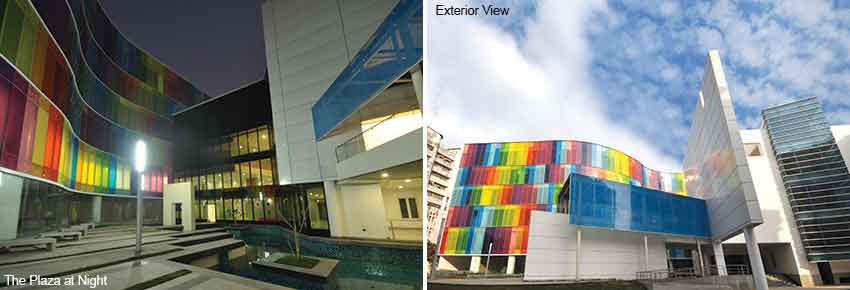
The client brief required a management institute of international standards. Provisions for state-of-the- art facilities and smart classrooms have been made for. The latest technological provisions in the institute allow for worldwide exchange of knowledge through conventions and seminars. The architectural language of the built form is a representation of this. The colored façade gives it a unique identity.
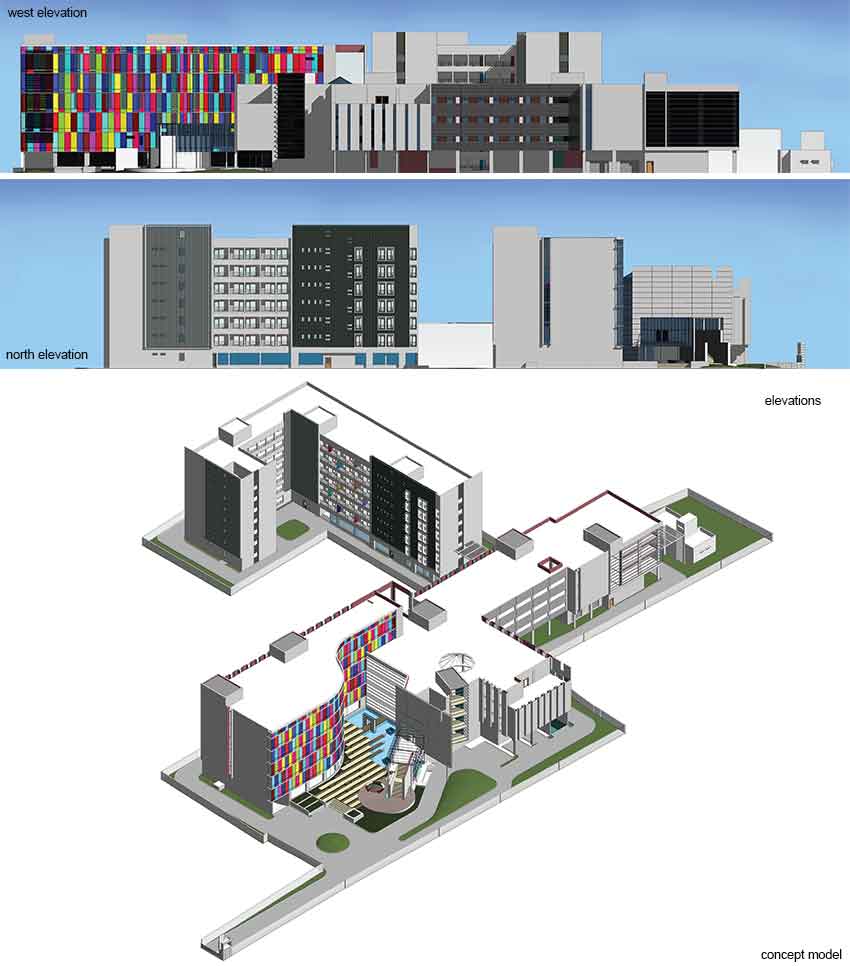
| At a Glance | |
| Location | : Kolkata |
| Function | : Education |
| Site Area | : 2.75 Acres |
| Building Area | : 5000 Sq M |
| Total Floor Area | : 27000 Sq M |
| Principal Architect | : Abin Chaudhuri (Principal) |
| Client | : IMI, Kolkata |
| Interior/ Landscape Design | : Abin Design Studio |
| Principal Civil Contractor | : Mfar Constructions |
| Principal Interior Contractor | : Touchpoint |
| Photographer | : Pradip Sen |
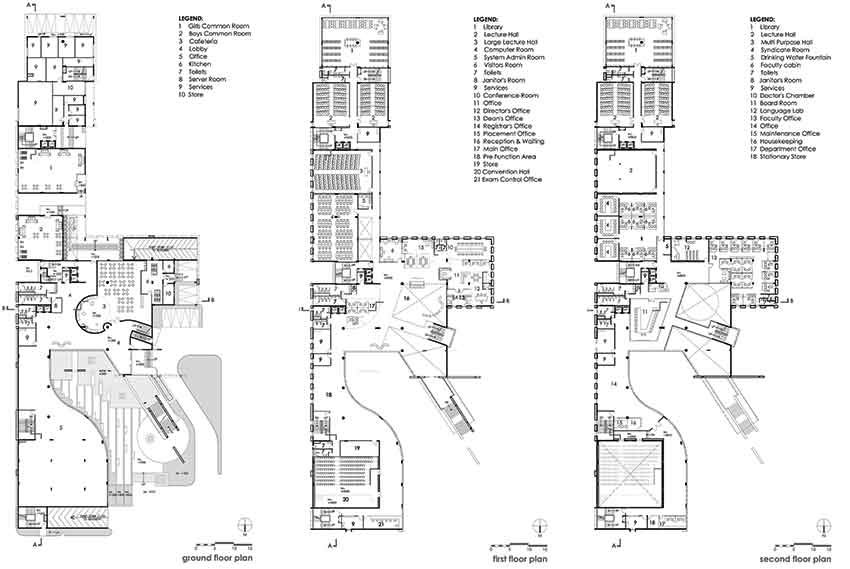
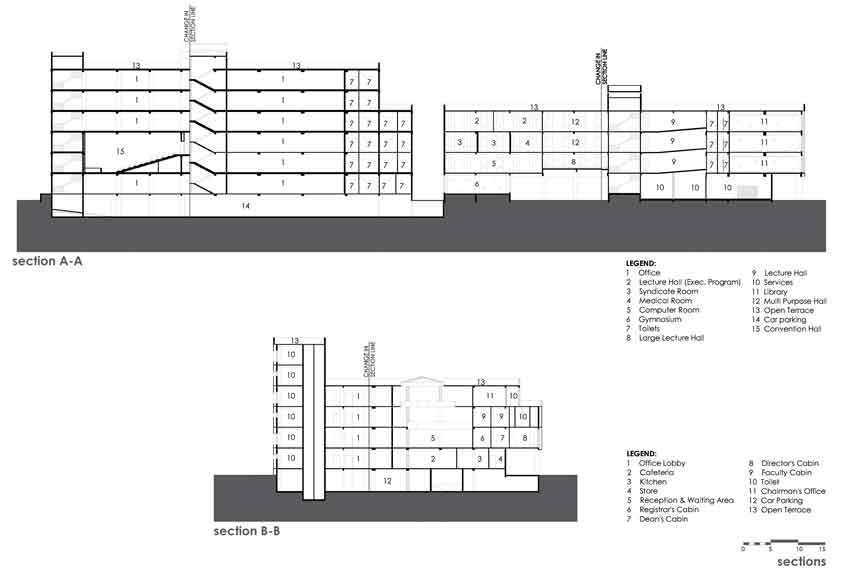
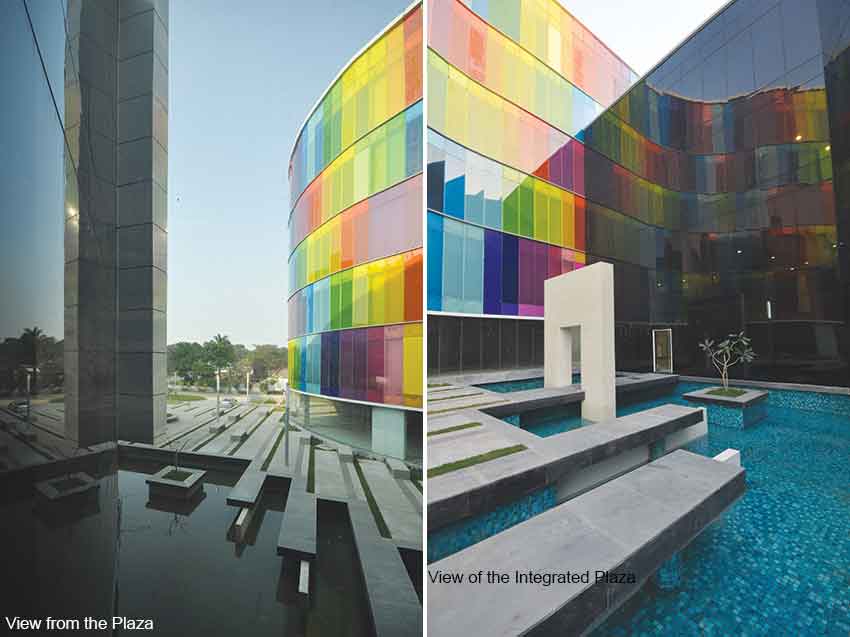
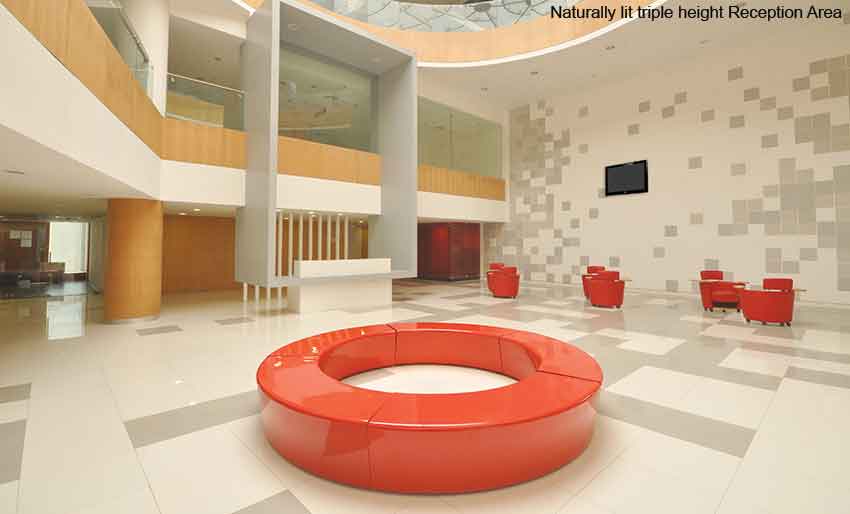
The building situated in a very dense residential urban fabric, was a huge constraint and dictated linear planning. Special efforts were made to ensure create non-monotonous spaces which did not follow expected linear pattern. The narrow entrance to the site did not allow a naturally large frontage and curve glass façade was designed such that it would create the necessary frontage for an institutional building.
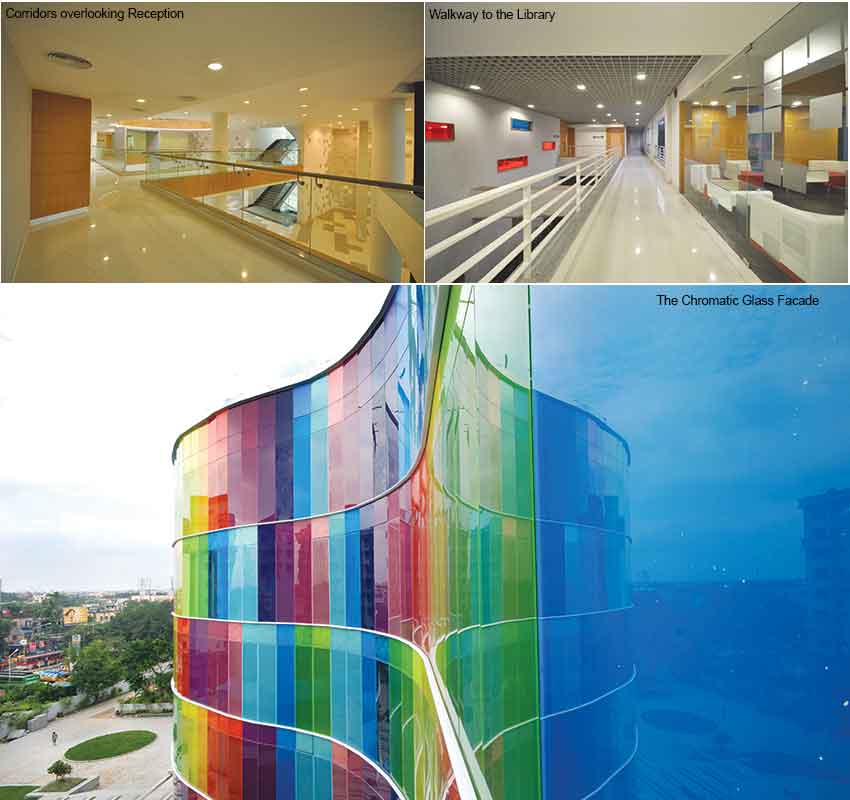
The chromatic glass façade comprises 2 layers of 5mm clear glass each with an intermediate PVB layer 1.2mm thick which acts as an insulator, reducing the heat buildup inside. The façade becomes more dynamic by night when the inside lights are switched on and has a mesmerizing effect on the plaza below. The circulation spaces and spill out zones have been created along the curved glass façade, allowing them to be naturally lit in the day and giving them a more interesting and dynamic feel. Emphasis has been given to interaction points not just for students but also for the faculty encouraging exchange of knowledge and ideas at all levels.
The reception has been designed as a triple height space naturally lit by a huge skylight above. The corridors and spill out spaces culminate around here at the upper floor levels. Care has been taken to ensure that the library is also well lit during the day and has been designed such that it is surrounded by glass on three sides, shaded by the existing trees on site.
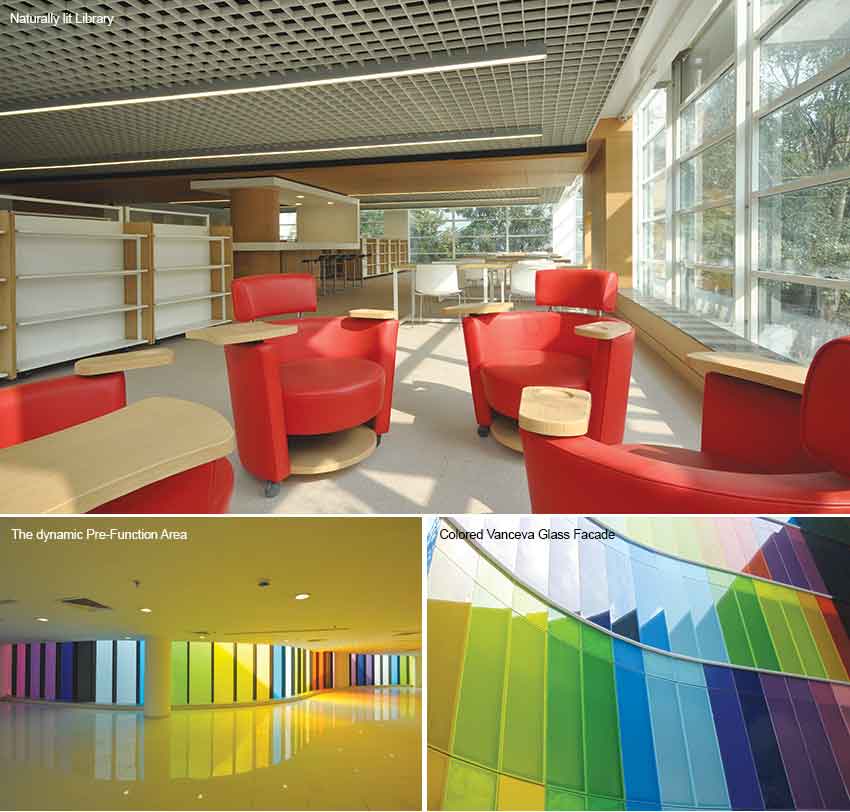
Color has subtly been introduced in the interiors as well in the form of colored glass partitions, colored glass slits on the wall or simply in the furniture. An integrated plaza with a water body has been designed. The water body receives no direct sunlight and creates a comfortable micro-climate. Wherever possible shading trees have been planted and soft landscape is introduced.
It is an institute that has achieved international standards not only by providing state-of-the-art facilities but also by having an architectural expression which represents that.

